Abandoned F
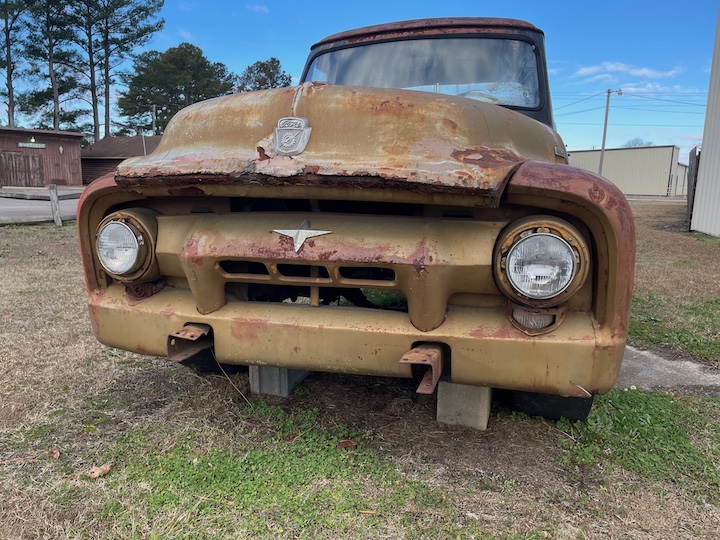
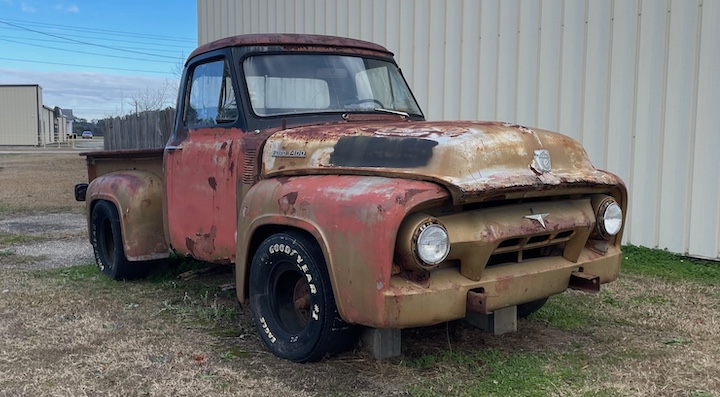
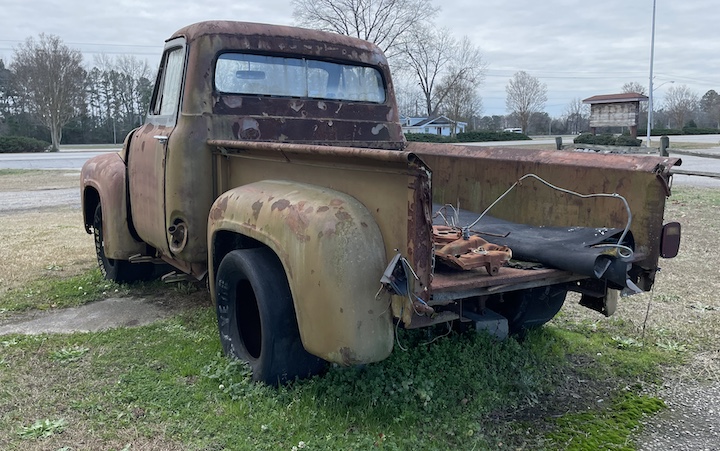
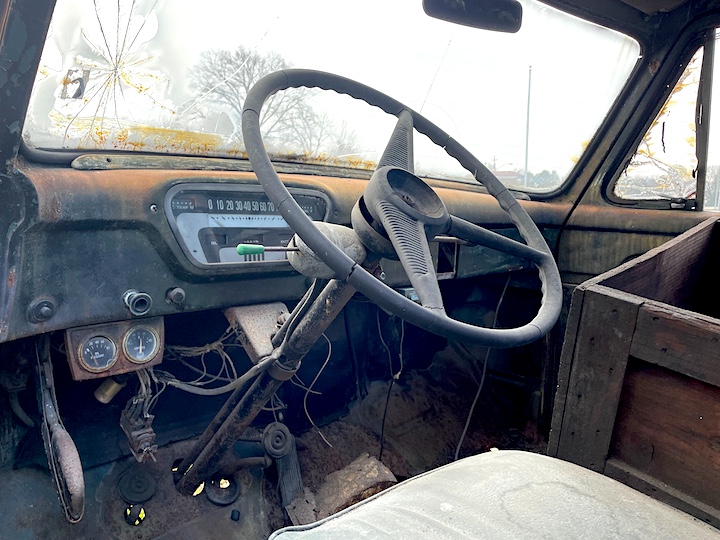
FORD (1954) — The grille of this 1954 Ford F-100 indicates that the truck carried a revised six-cylinder engine making 115 horsepower. This second-generation F-Series pickup featured a new hood badge with a lightning bolt/gear-wheel motif. Ford started building the F-series pickups in 1948. The second generation was built from 1953 through 1956. (Photos by Jim Meachen)
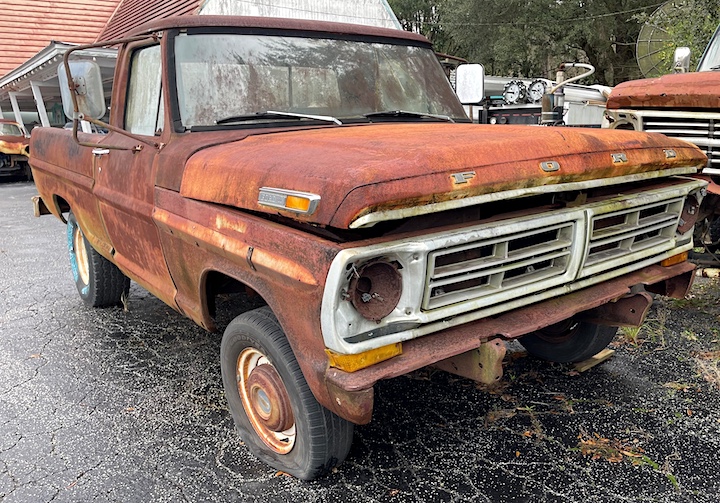
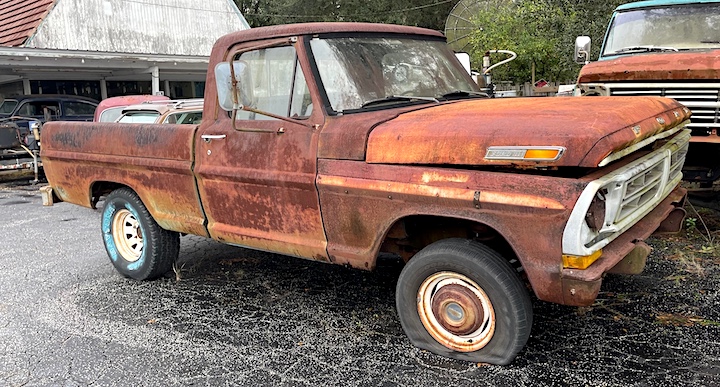
FORD (1971) — This fifth-generation 1971 Ford F-Series truck was found in northern Florida minus a few necessities such as headlights, bumpers and side trim. The 1971 F-Series had a variety of six and-eight cylinder engines. Transmissions included 3 and 4-speed manuals and a 4-speed automatic. (Photos by Jim Meachen)
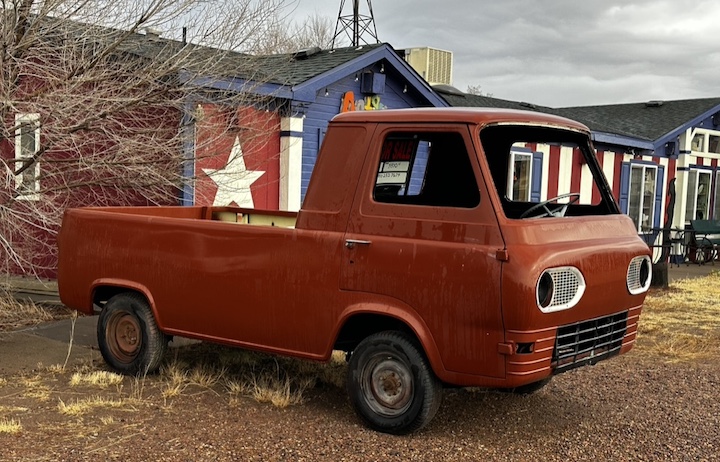
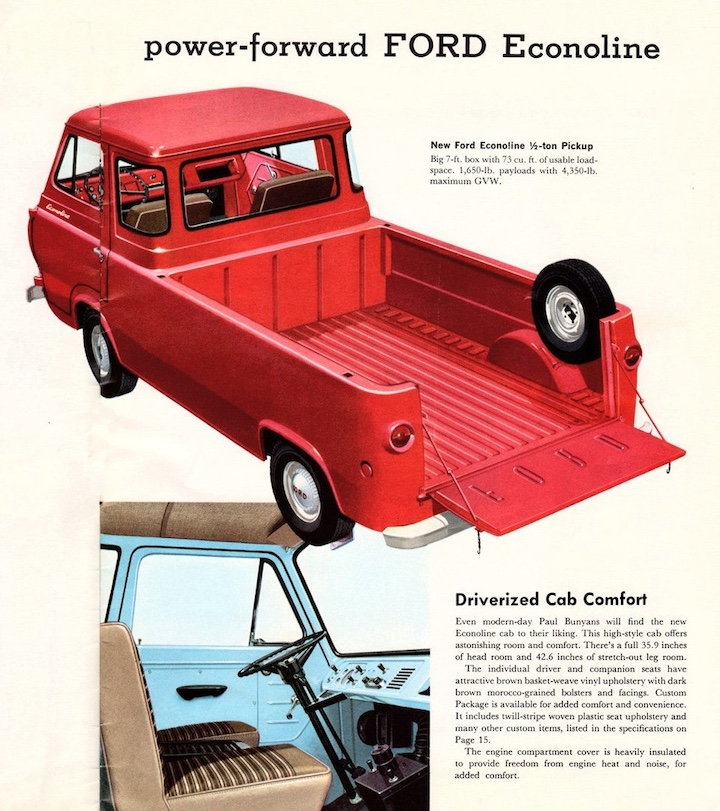
FORD (circa 1961-63) — This early 1960s Ford Econoline pickup truck looks as if it's ready for restoration. Based on the compact Ford Falcon, the first Ford Econoline utility van and pickup was introduced to the public on Sept. 21, 1960, for the 1961 model year. The design put the driver on top of the front axle with the engine near the front wheels, called "cab over." Early models sported a 144 cubic inch (2.4 L) inline 6 engine with a three-speed manual transmission. (Photo by Jim Prueter)
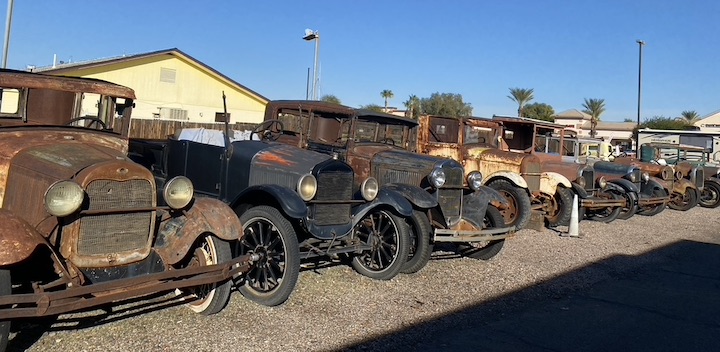
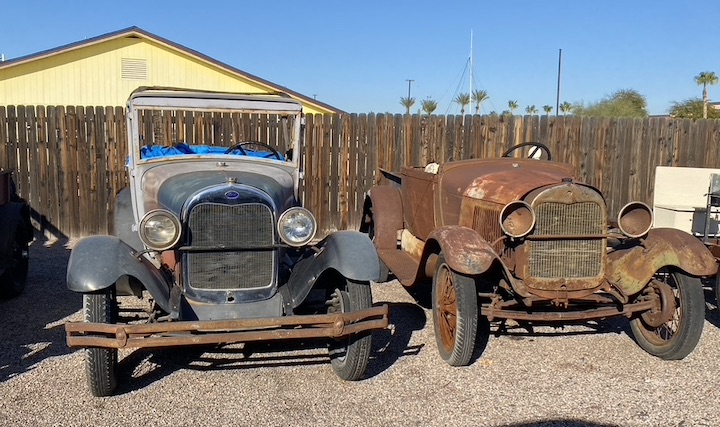
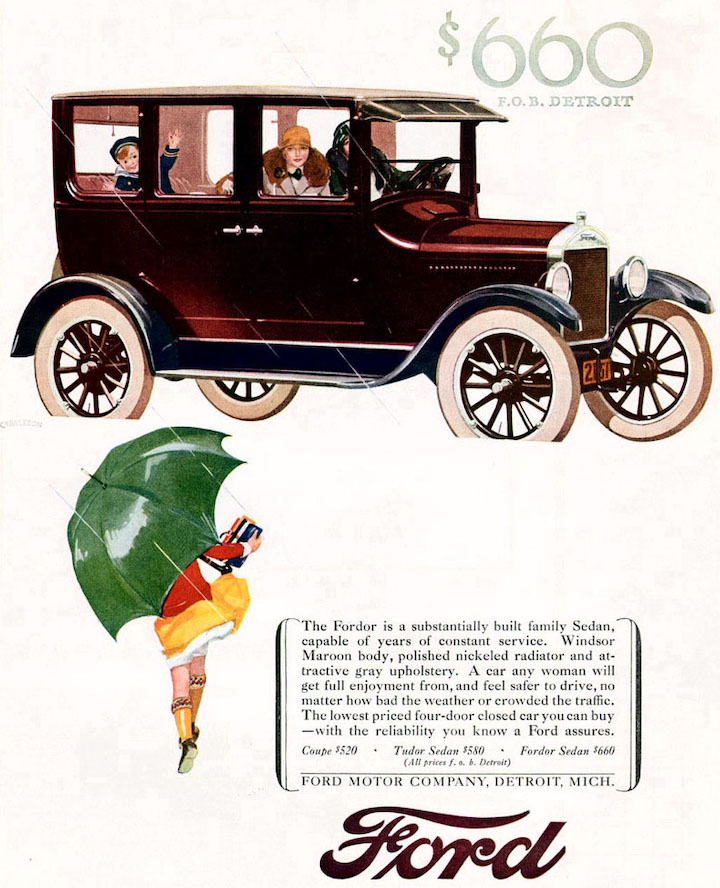
FORD (Late 1920s) — A collection of Model T and Model A Fords was discovered in an Arizona scrap yard this winter. The Model T was the first mass produced car, and in its last year in 1927 could be purchased for as low as $360 (equivalent to $5,616 in current dollars). The Model T finally gave way to the more modern Model A in 1928. Ford produced 15 million Model T cars and trucks from 1908 through 1927. (Photos by Jim Prueter)


FORD (1949-1951) — This stripped down circa 1949-51 Ford might end up completely abandoned or perhaps a new life might be in its future. The '49 Ford was the company's first all-new car since the end of World War II. The new Ford pushed the company to number one in U.S. sales for 1949. There were two engine options, an inline 6 or a flathead V-8. (Photo by Jim Meachen)
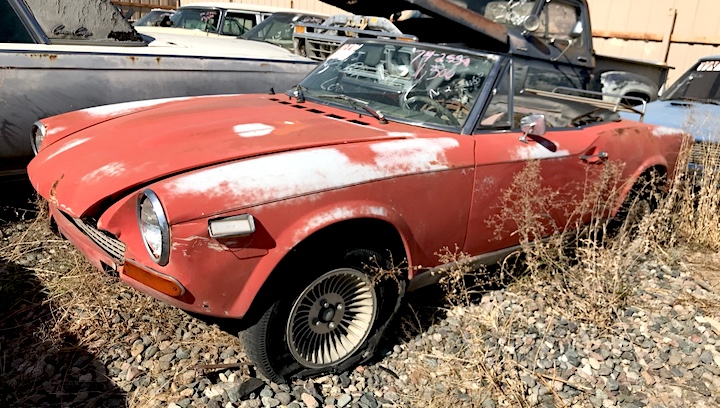
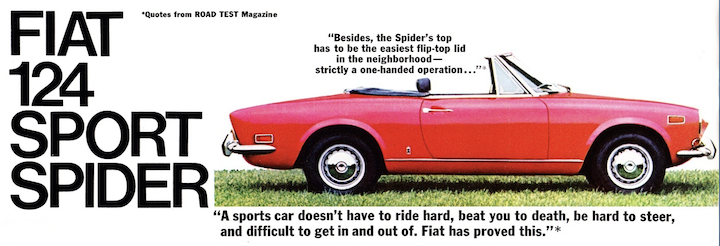
FIAT (crca 1970) — This early circa 1970s Fiat 124 Spider was found in retirement in an Arizona salvage yard. It appears from the scrawling on the windshield that the owner thinks the relic is still worth $1,500. The original two-seater was built by the Italian company from 1966 through 1985. The first 124 was powered by an inline four-cylinder engine making 89 horsepower. (Photo by Jim Prueter)
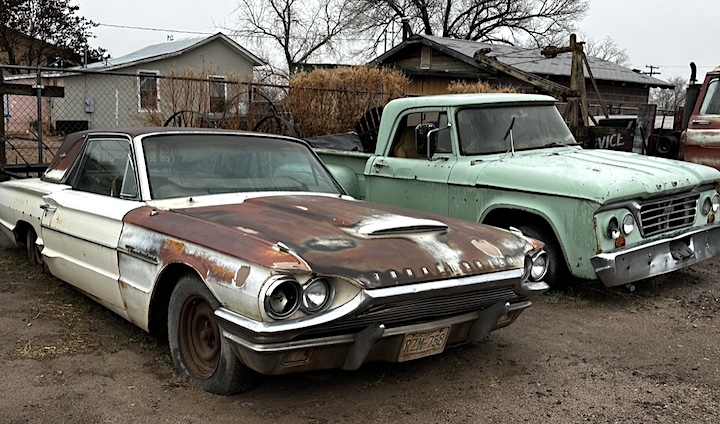
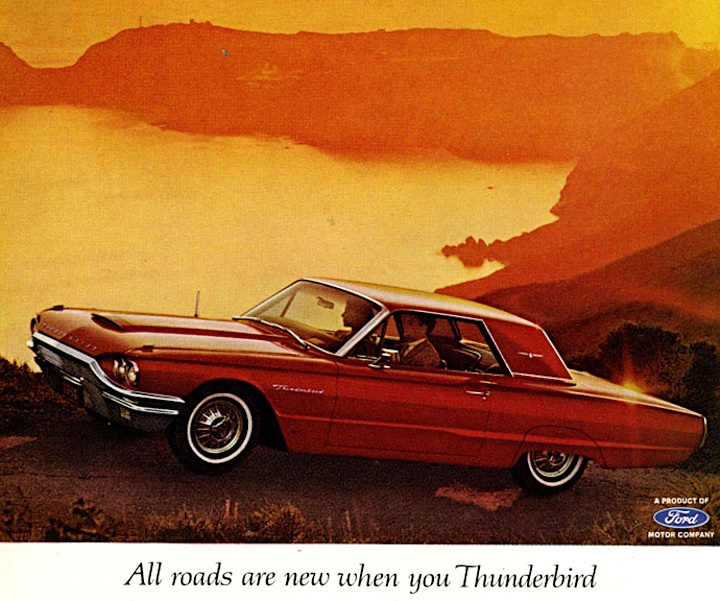
FORD (1964) — A 1964 Ford Thunderbird and a circa 1961-64 Dodge pickup live in abandoned bliss in New Mexico. The '64 Bird kicked off the fourth generation and was a big leap forward in design over the third generation Thunderbird. The standard engine was a 300-horsepower V-8. The Dodge D series pickup was introduced in 1961 and sold through the 1993 model year. The first generation of the D series was built through 1965. (Photo by Jim Prueter)
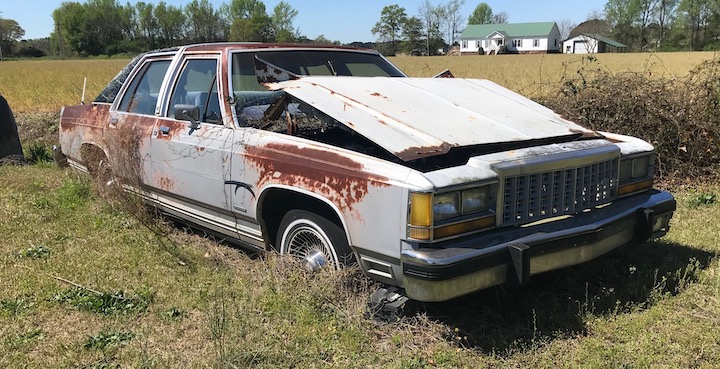
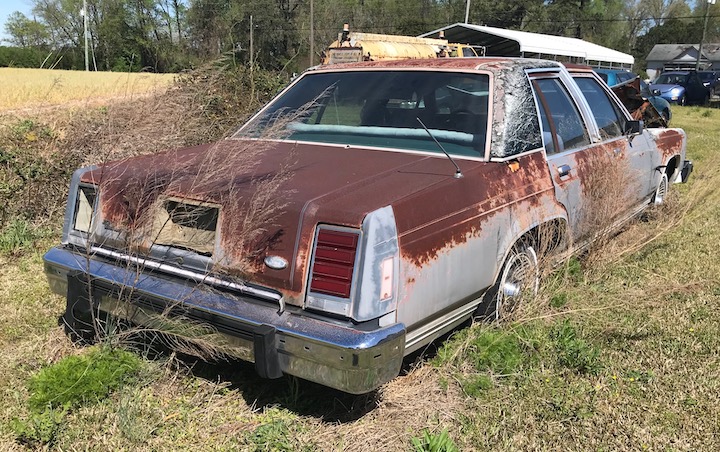
FORD (1979-1982) — This third-generation Ford LTD (1979-1982) was found languishing behind a repair shop in eastern North Carolina. The third-generation was downsized from the previous iteration losing about 15 inches of body length and seven inches of wheelbase. Available was a 5.0-liter and 5.8-liter V-8. Ford built 356,535 LTDs in coupe, sedan and wagon variants in 1979. Sales tumbled to 141,562 in 1980. (Photos by Jim Meachen)
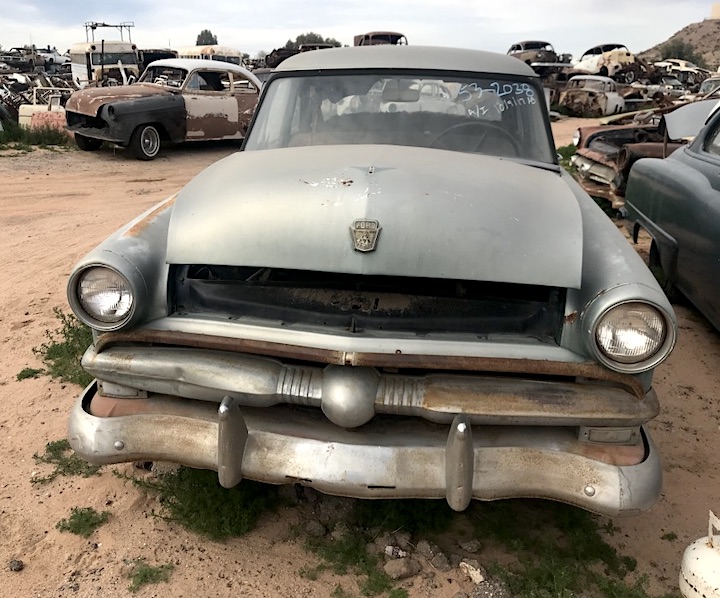
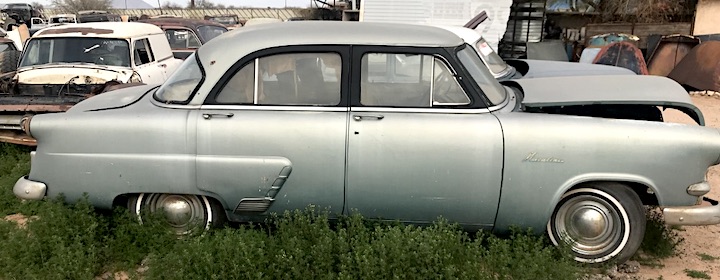
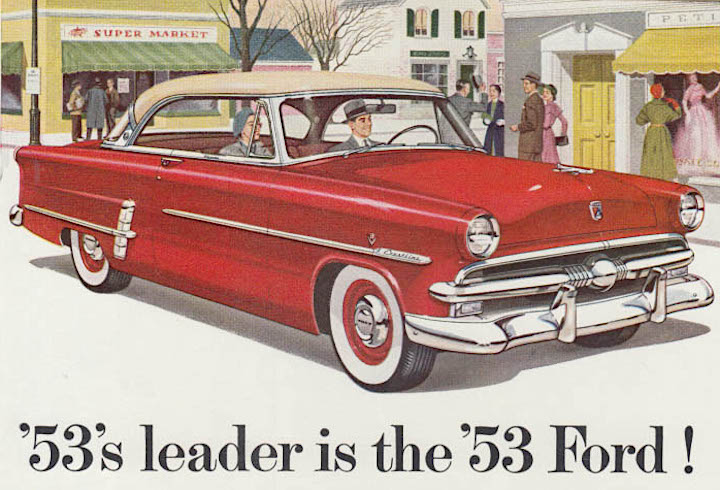
This 1953 Ford sedan has found a retirement home among other relics in an Arizona salvage year. Ford was riding high in the 1950s, alternating with Chevrolet for the title as best-selling nameplate. Ford was number 2 in 1953, but rebounded into the top position in 1954. The standard-sized Ford was all new in 1952 and with only cosmetic changes through 1954, when it was totally redesigned in 1955. (Photos by Jim Prueter)
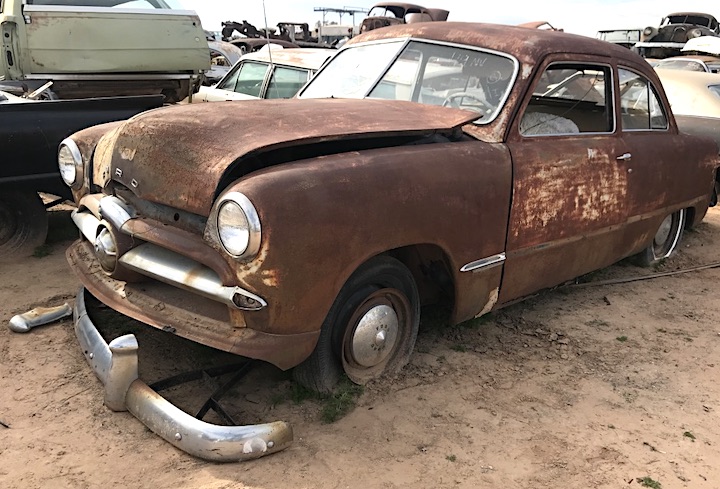
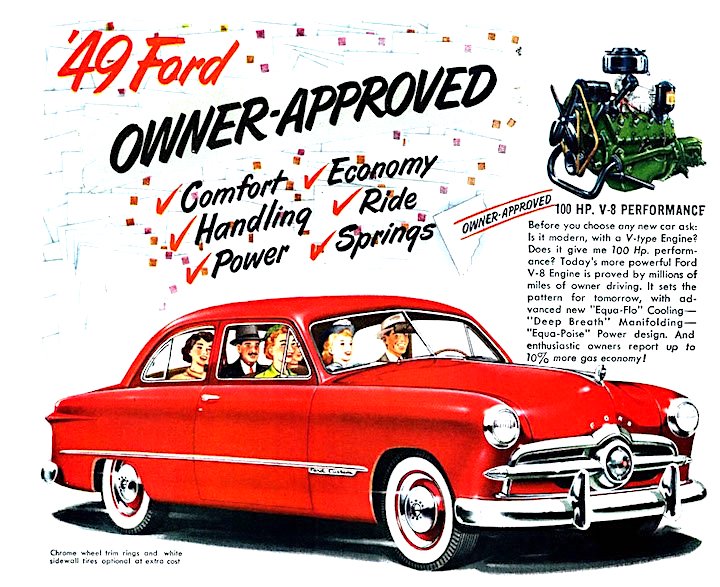
FORD (1949) — The 1949 Ford is the first full-size Ford designed following World War II and the first Ford released after the deaths of Edsel Ford and Henry Ford. Ford was the first post-war America car line with an all-new model beating Chevrolet to market by six months and Plymouth by nine months. 1949 was a good sales year for Ford, which edged out Chevrolet for the top spot with 1,118,308 sales. This survivor was found in Casa Grande, Ariz. (Photo by Jim Prueter}
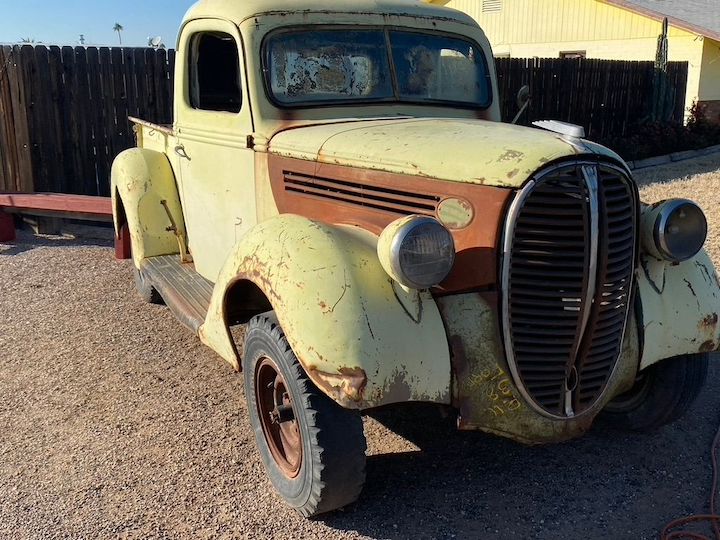
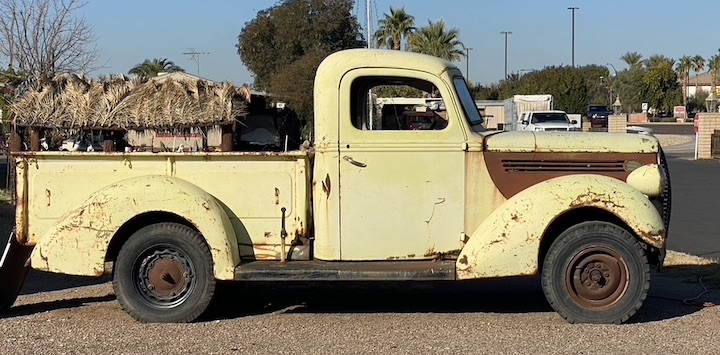
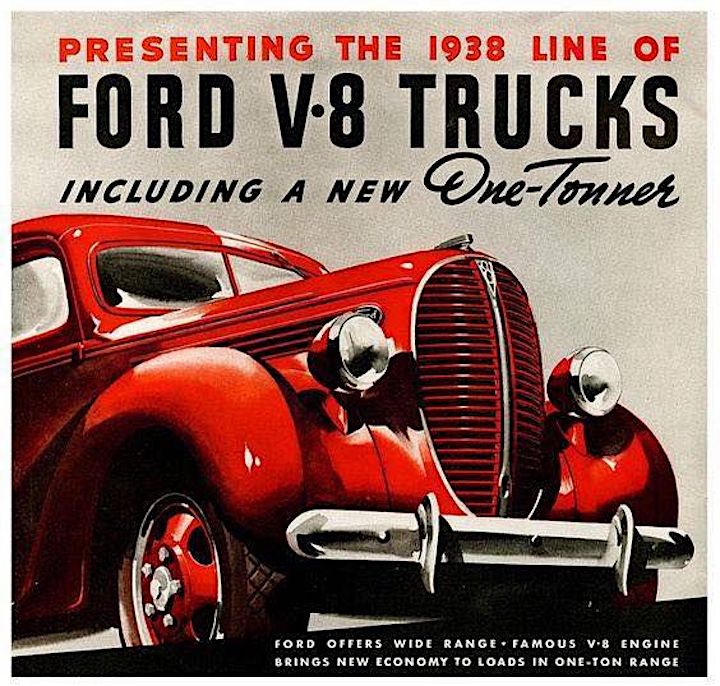
FORD (1938-1939) — This circa 1938-1939 Ford pickup was found in fairly good condition in Arizona. The 1938-1939 Ford panel and pickup truck bore little resemblance to the Ford trucks that had come before. They were treated to a thorough restyle in 1938, and carried over unchanged into 1939. Both the 60-horsepower and 85-horsepower V-8 engines were offered. (Photos by Jim Prueter)
FORD (circa early '30s) — An early 1930s Ford pickup serves as an unusual patriotic yard ornament in Washington state. Ford battled with Chevrolet for U.S. sales supremacy during the first half of the 1930s with 1930 Ford's biggest sales year of the period at 1,140,710. Chevrolet's biggest sales year was also 1930 with 640,980 sales. (Photo by Jim Meachen)
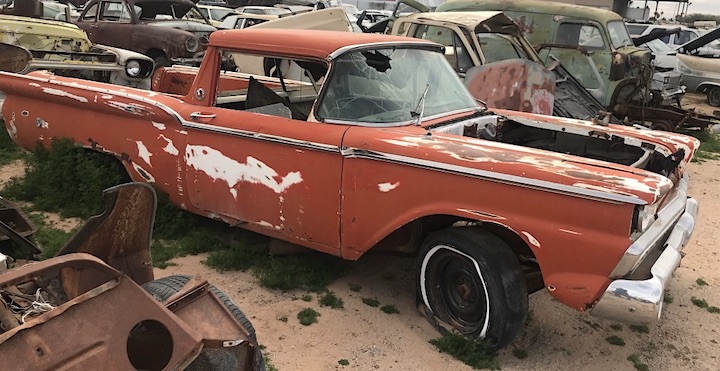
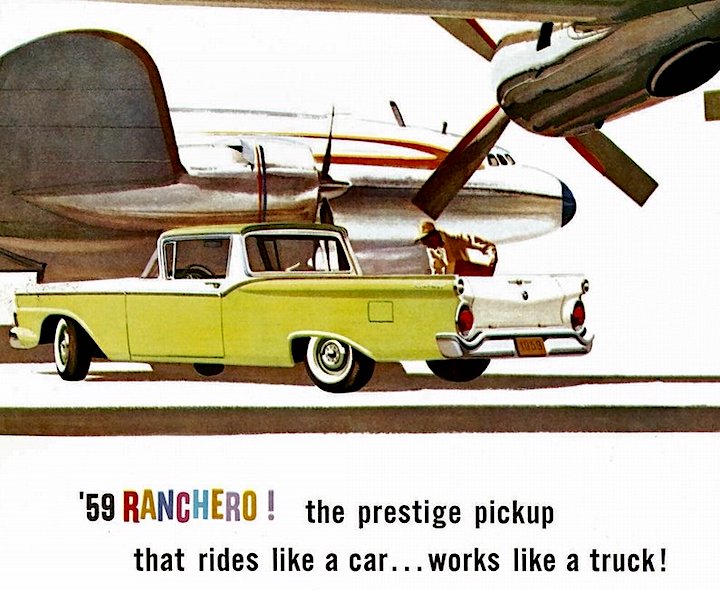
FORD (1959) — The Ford Ranchero is a coupe utility that was produced by Ford between 1957 and 1979. Unlike a standard pickup truck, the Ranchero was adapted from a two-door station wagon platform that integrated the cab and cargo bed into the body. A total of 508,355 units were produced during the model's production run. Over its lifespan it was variously derived from full-sized, compact, and intermediate automobiles. This first-generation 1959 Ranchero was found rusting away in an Arizona salvage yard. (Photo by Jim Prueter)
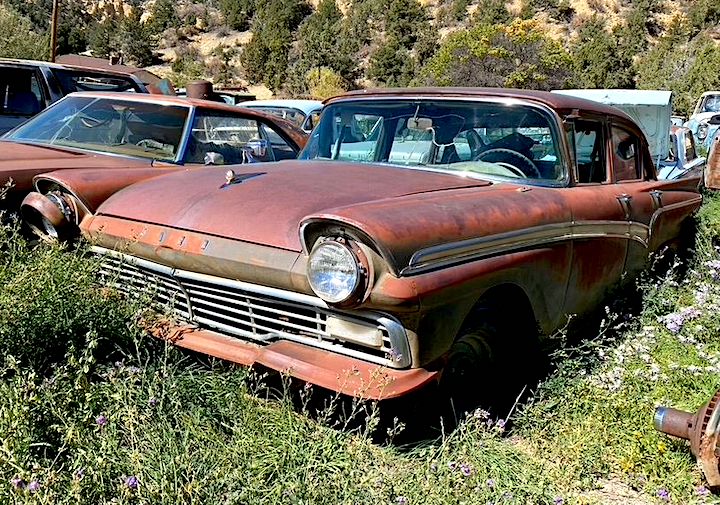
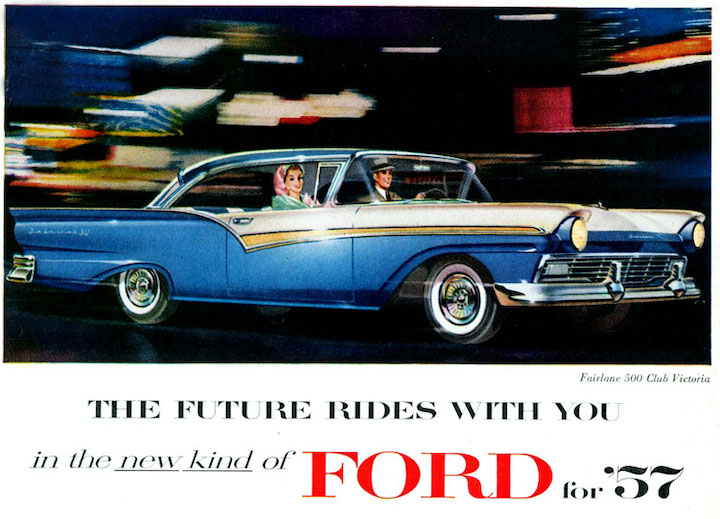
FORD (1957) — The 1957 Ford was one of the company's biggest hits through the years, although it was outshined by the '57 Chevrolet, which has become a classic auction favorite. There were 11 varieties of the Ford including a retractable hardtop convertible and two-door and four-door station wagons. This 1957 four-door sedan was found in a Utah salvage yard. Ford actually outsold Chevy in '57 — 1.67 million to Chevy's 1.5 million. (Photo by Jim Prueter}
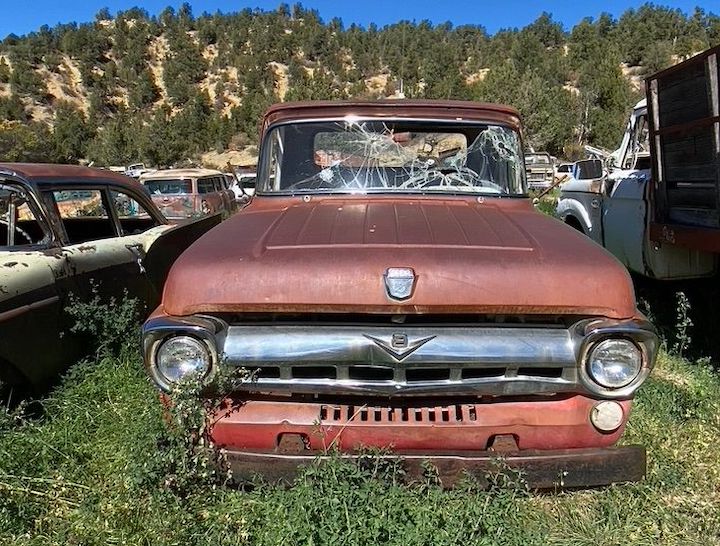
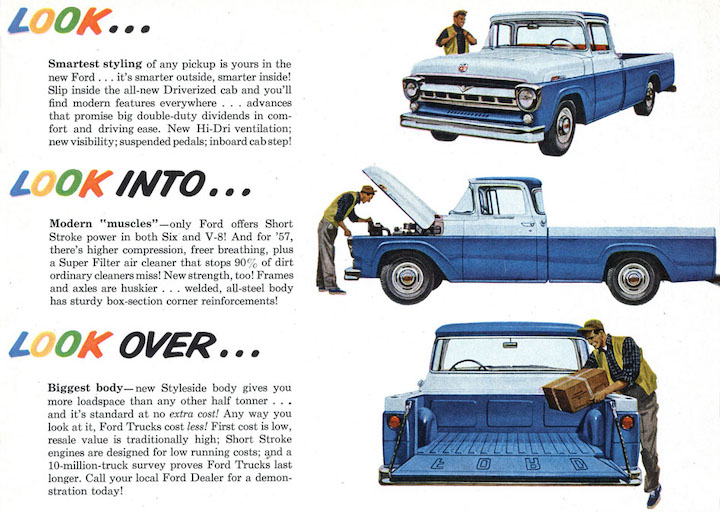
FORD (1957) — This 1957 Ford F-Series pickup was found in Utah. The '57 is the first year of the third generation F-Series, which was built through 1960. The third generation was a significant modernization and redesign for the F-Series, which originated in 1948. (Photo by Jim Prueter)
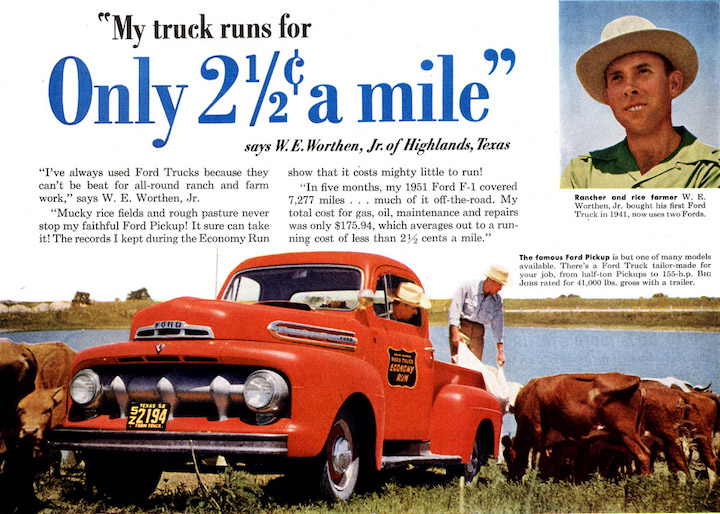
FORD (1951-1952) — The 1951-1952 Ford pickups were part of Ford's "Bonus Built" postwar trucks, which ran from 1948 through 1952. The trucks had two wheelbases: 114 inches for the 1/2-ton F-1 series, 122 inches for the 3/4-ton F-2. By the time the 1951 Ford pickup appeared, the gearshift had moved from the floor to the steering column. The 1951 Ford pickup also introduced a new front end. Gone was the smiling horizontal-bar grille and inboard headlamps, replaced by a single-bar grille with three massive "teeth." Along with a wraparound front bumper, this gave Ford trucks a more aggressive frontal appearance. This relic was found on the side of a road near Boone, N.C. (Photo by Jim Meachen)
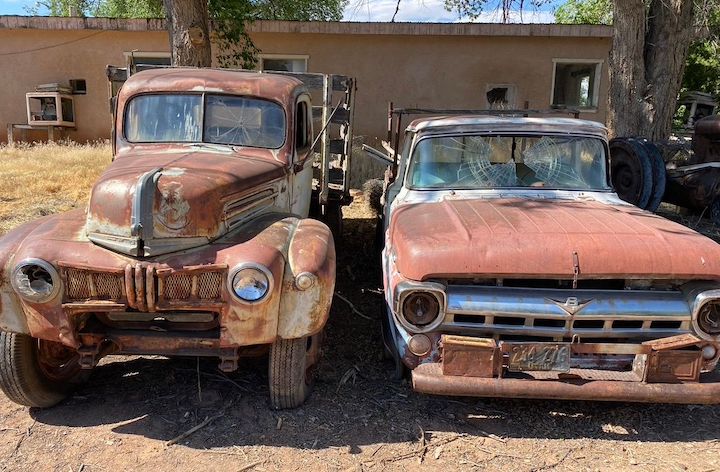
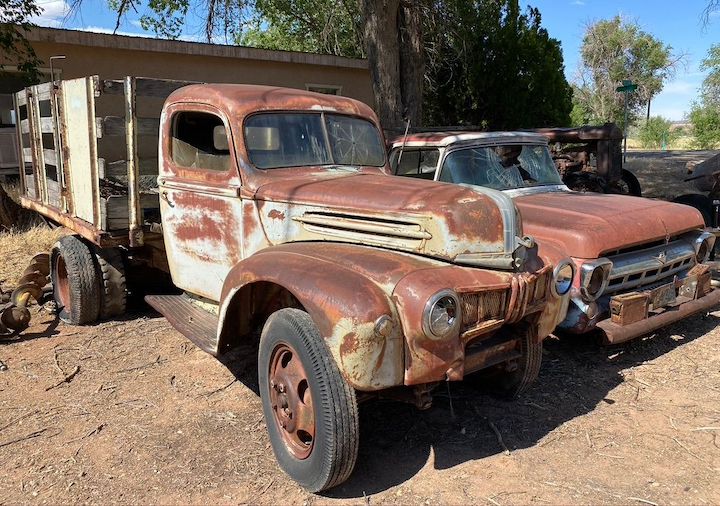
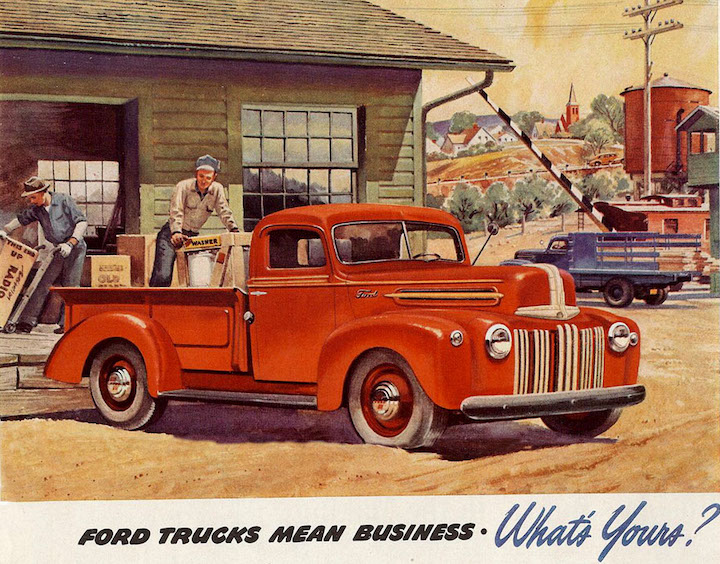
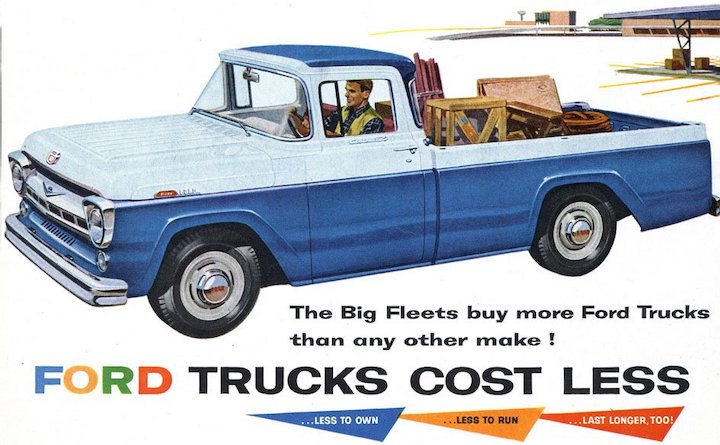
FORD (1946 & 1957) A 1946 Ford truck shares time in retirement with a 1957 Ford pickup in Utah. Ford redesigned its 1942 trucks, which sold in limited numbers because of the onset of World War II. The 1942 design was carried over into the 1946 model year when sales resumed. Two engines were available — a 90-horsepower inline 6 and a 100-horsepower V-8. Ford completely restyled its pickup for 1957. The '57 came in Styleside and Stepside configurations. (Photos by Jim Prueter)
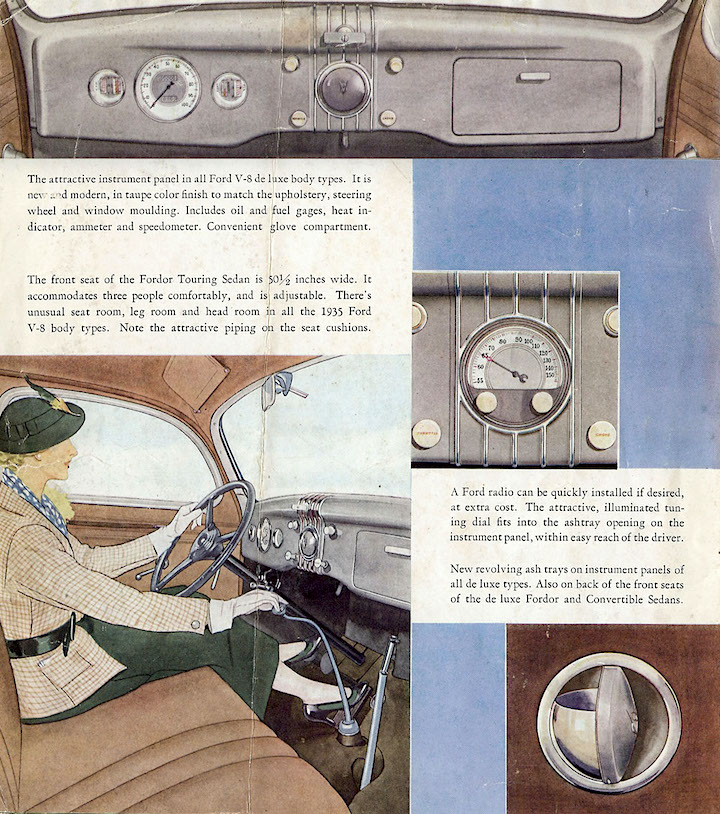
FORD (1935) — The 1935 Ford came with a flathead V-8 engine in 1935, being introduced in 1932. It was the first "affordable" V-8 engine on the market. Affordable meant a 1935 sedan started at just $655. Not only did the 1935 have eight cylinders, it could be ordered with a radio for the first time. The dashboard was neatly designed with three round gauge clusters, the speedometer in the middle. To the right, partially hidden by the steering wheel, was the ashtray cutout, which was used to house the radio. Philco, a pioneer in radio production, manufactured the radio for Ford at an option price of $44.50. The advertisement above describes the "illuminated tuning dial" on the radio and the revolving ashtray. (Photo by Ralph Gable)
FORD (mid-60s) —This mid-1960s Ford farm truck appears to be at the end of its useful life. It was discovered by the side of a rural road in eastern North Carolina. (Photo by Jim Meachen)
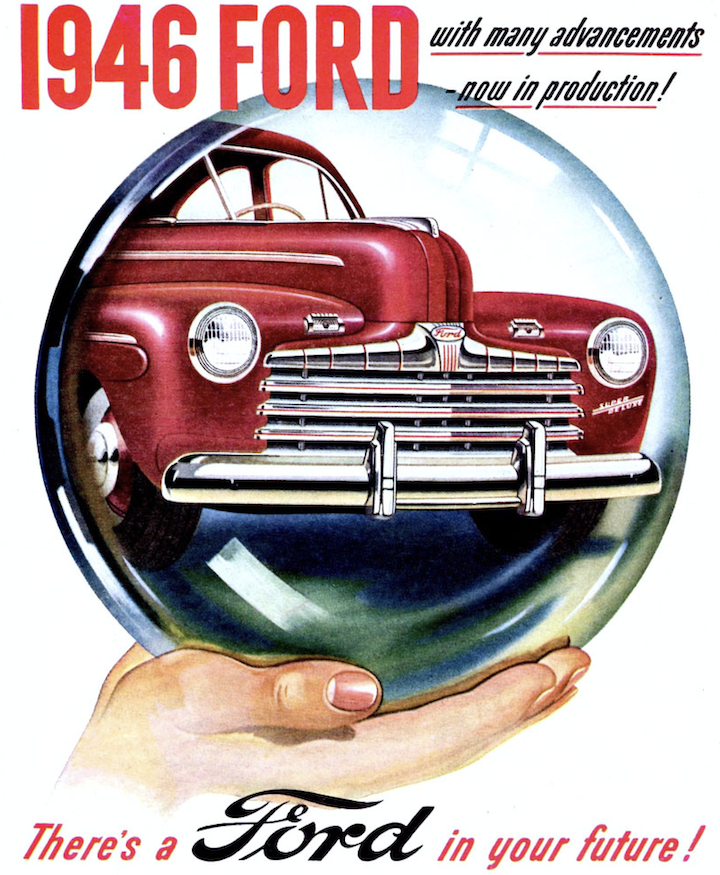
FORD (1946) — In 1946 Ford beat out Chevrolet in marketing a new car immediately following the end of World War II, with the Super Deluxe Tudor sedan. All Ford body styles were carried over from the discontinued 1942 model. The Ford came with a 239 cubic inch V-8 making 100 horsepower. Ford outsold Chevrolet 468.022 to 398,028 in 1946 before Chevy recaptured the "best selling brand" title in 1947. Some of Ford's post-war success came from Ford's ad agency, which coined the phrase, "There's a Ford in your future." This 1946 Super Deluxe was found in eastern North Carolina. (Photos by Jim Meachen)
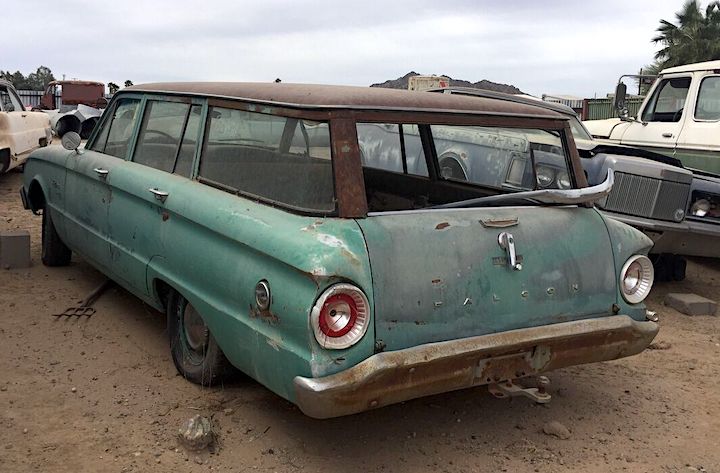

FORD (1960-63) — This circa 1960-1963 Ford Falcon wagon was found in a salvage yard in Maricopa, Ariz. It's from the first-generation Falcon, which was built from 1960-1963. Standard on the compact-sized Falcon was a 2.4-liter 4-cylinder engine making 95 horsepower. A 3-speed manual was the standard transmission, with a 2-speed Ford-O-Matic automatic as optional. Station wagons came in two-door and four-door versions. (Photo by Jim Prueter)
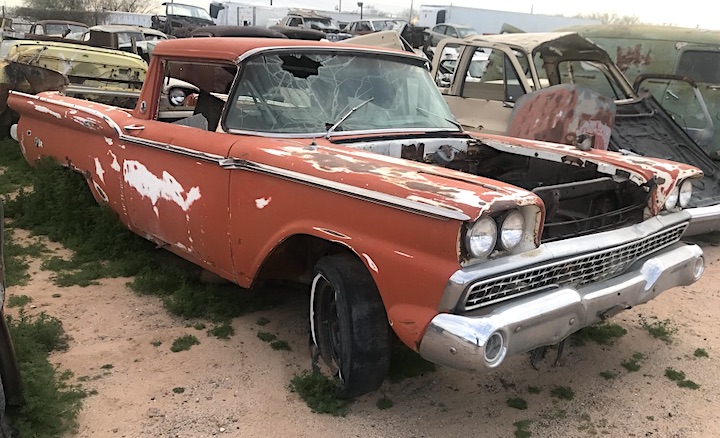

FORD (1959) — This used-up 1959 Ford Ranchero was found in a salvage yard in Casa Grande, Ariz. The Ranchero, built between 1957 and 1979, was originally adapted from a two-door station wagon platform that integrated the cab and cargo bed into the body. Over its lifespan it was variously derived from full-sized, compact, and intermediate automobiles sold by Ford for the North American market. Its chief competition was the Chevy El Camino. (Photo by Jim Prueter)
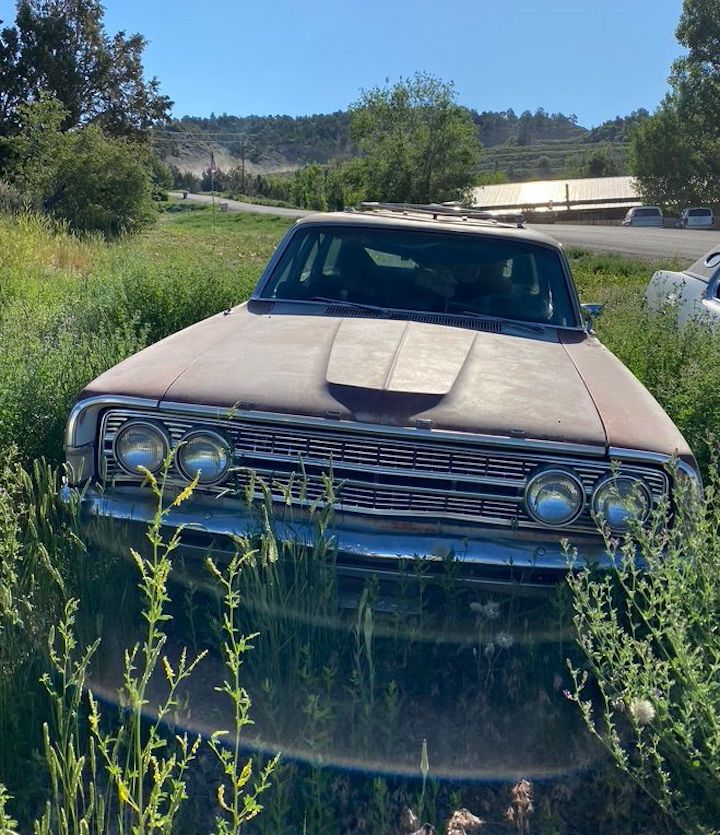
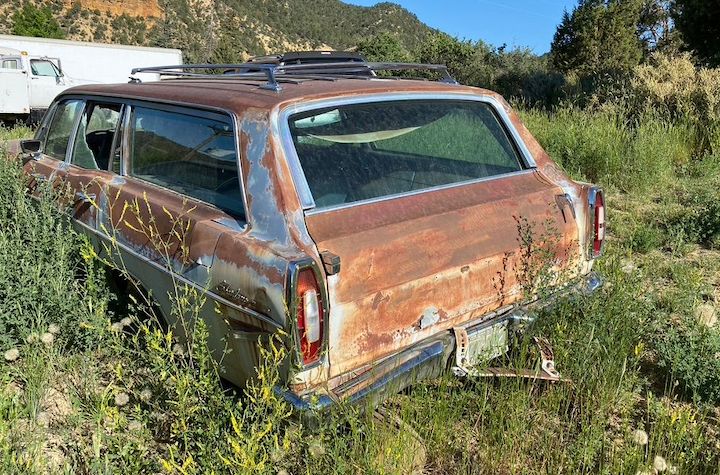
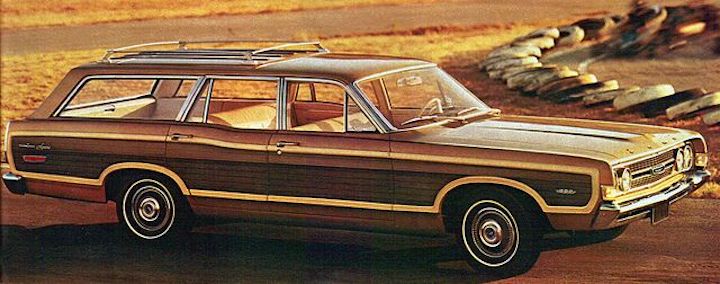
FORD (1969) — Ford built numerous station wagons in the '60s and '70s. For instance, in 1969 the Blue Oval had the large Country Squire, the mid-sized Fairlane/Torino wagon and a smaller Falcon wagon. This 1969 Torino Squire wagon was found in abandoned condition in Utah. (Photos by Jim Prueter)
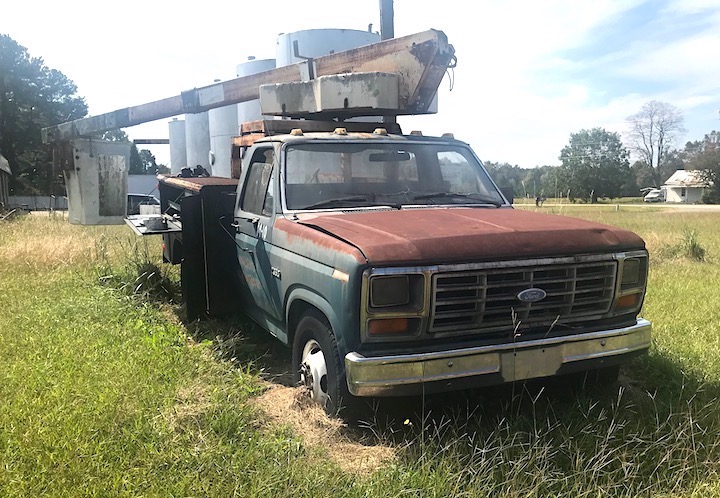
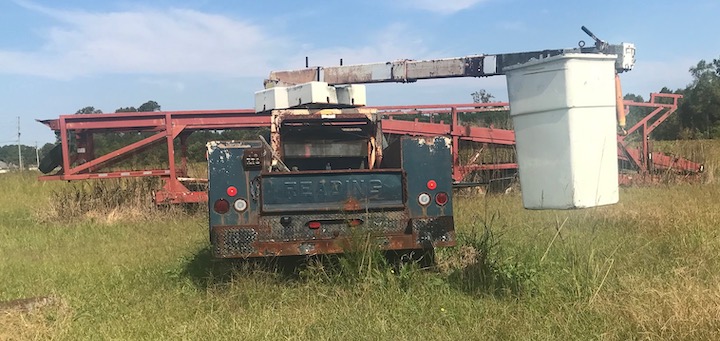
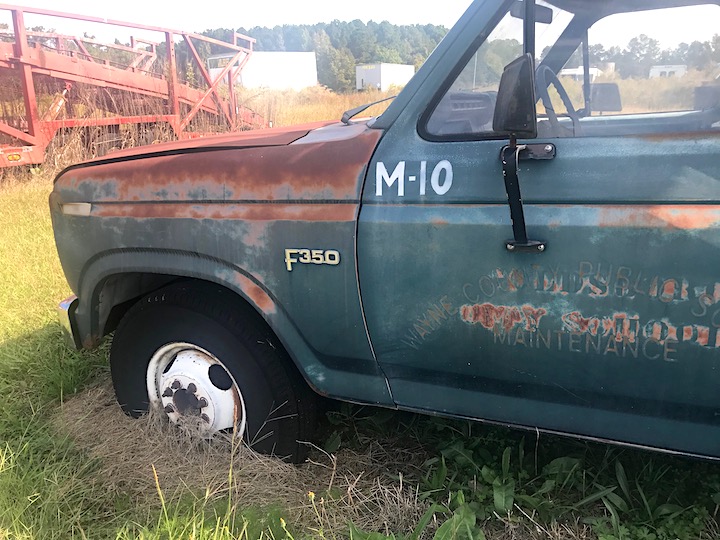
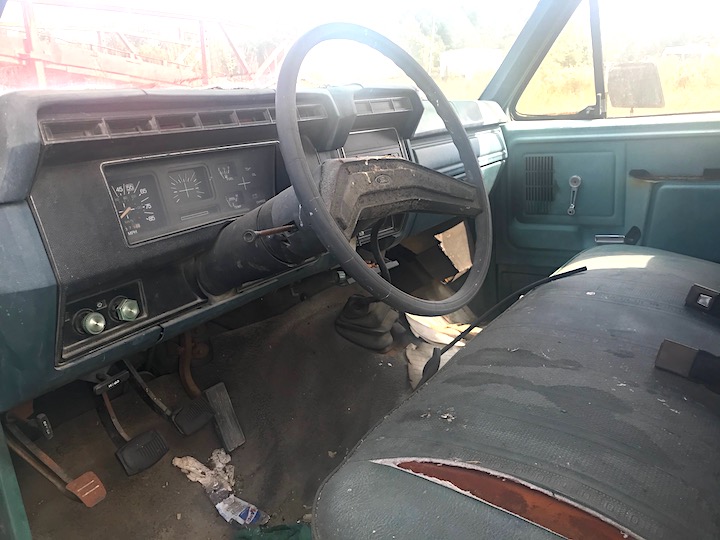
FORD (circa 1980-1986) — This circa 1980-1986 Ford F-350 work truck has been literally put out to pasture in southeastern North Carolina. 1980 marked the start of the seventh-generation truck and the first complete redesign since the 1965 model. The seventh generation receive a new chassis and body, distinguished by flatter body panels and a squarer grille. This architecture lasted through the 1998 model year. Numerous gas and diesel engines were available. (Photos by Jim Meachen)

FORD (1956) — Ford has built a medium duty truck since 1948, and it was redesigned for its second generation in 1953 becoming the F-500 and F-600. 1953 was the last year for the long-running Flathead V-8 replaced in 1954 with the 239-cubic-inch Y-block V-8. This 1956 F-600 was found languishing in a backyard in Hosmer, S. D. (Photos by Jim Meachen)
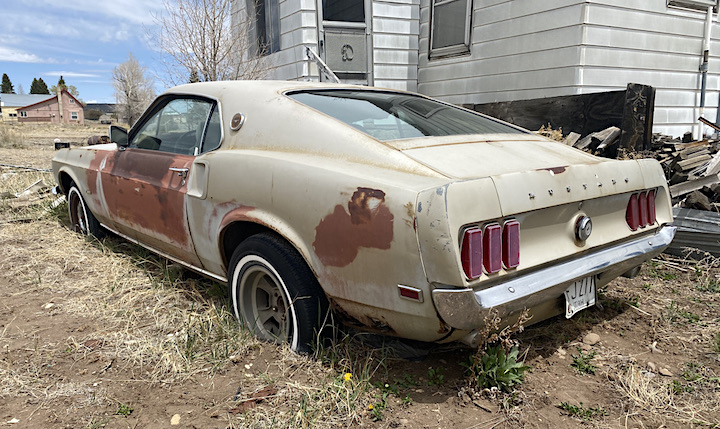
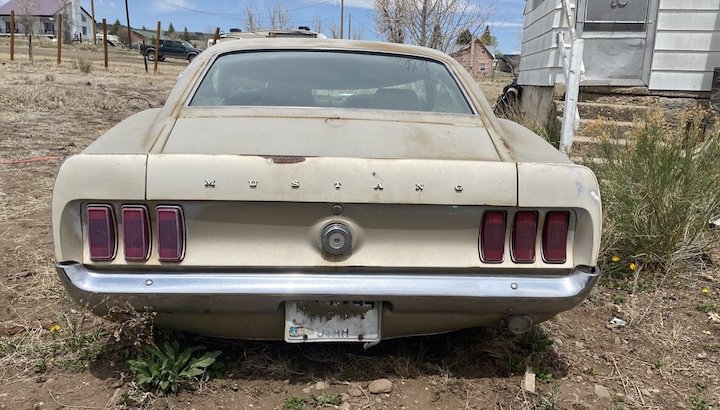
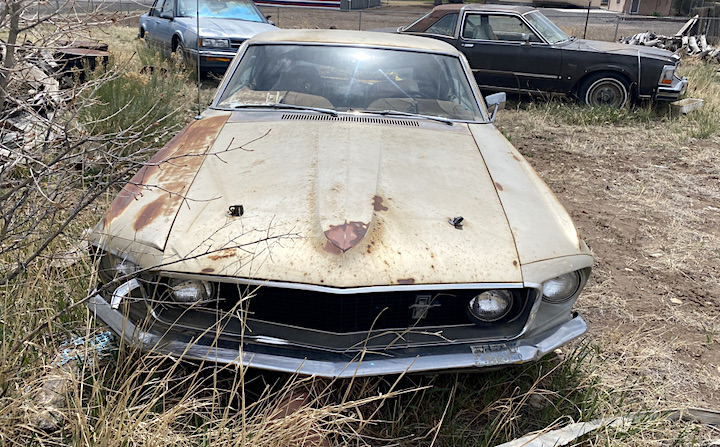
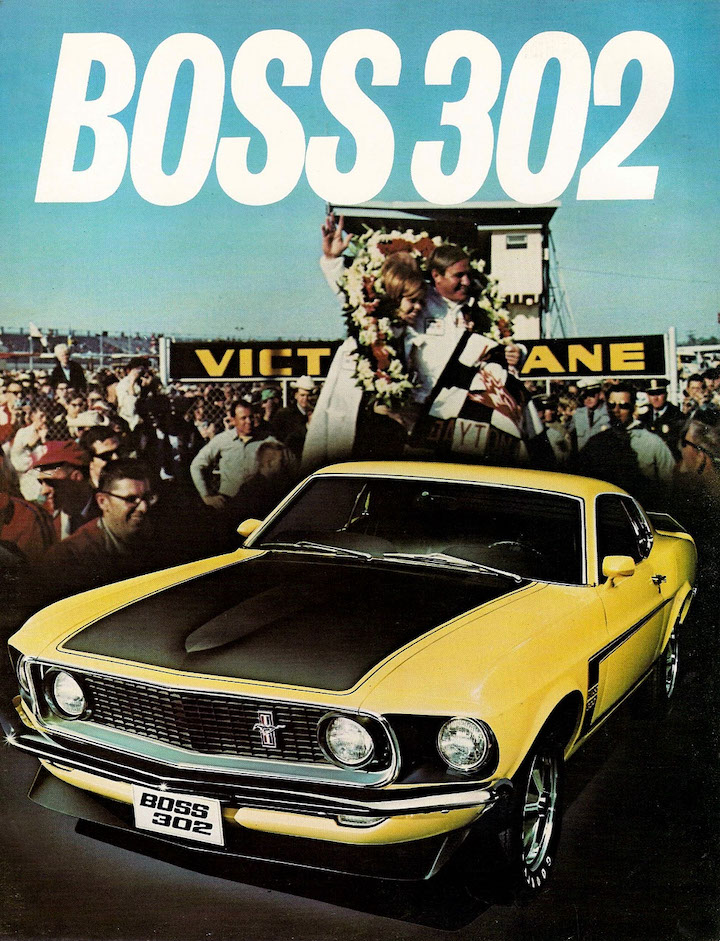
FORD (1969) 1969 was another good year for the popular Ford Mustang — which underwent some major restyling — with nearly 300,000 units sold. It came in coupe, convertible and fastback formats with the base engine a 200 cubic inch six cylinder. The base V-8 was a 302 cubic inch two barrel V-8. Six factory performance V-8 engines were available. This example was found languishing in Utah. (Photos by Jim Prueter)
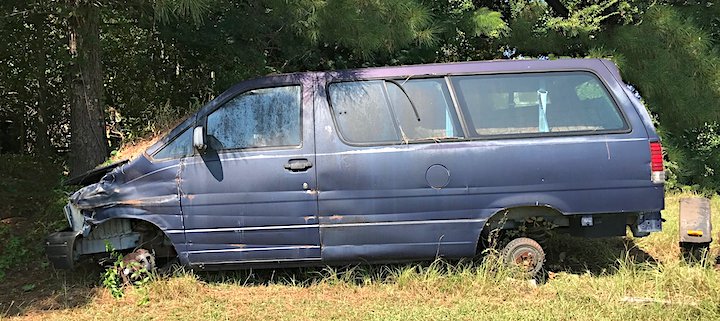
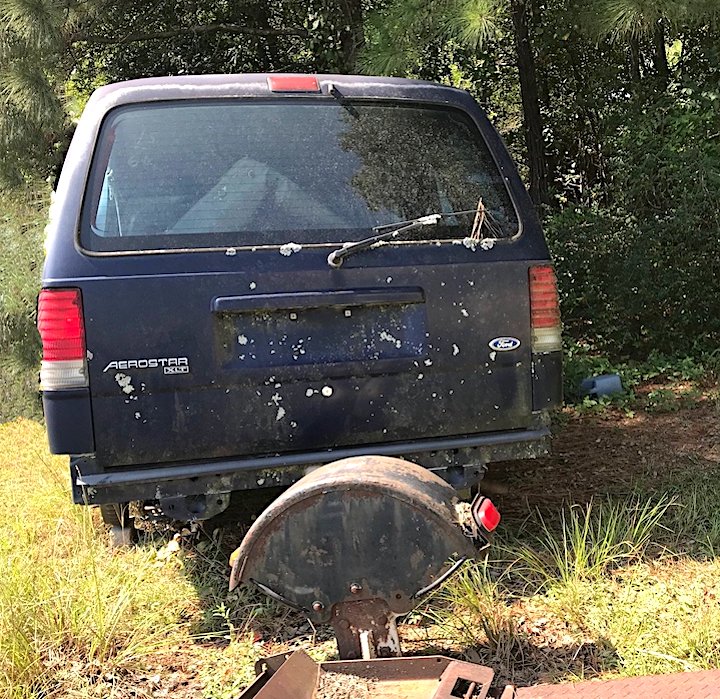

FORD (circa 1986-1997) — The Ford Aerostar is a range of vans manufactured by Ford from the 1986 through the 1997 model years. The Aerostar is considered the first minivan produced by Ford, marketed against the Chevrolet Astro/GMC Safari and the first two generations of the Chrysler minivans. The Aerostar derived its name from its slope-nosed "one-box" exterior. Four engines (one four-cylinder) and three V-6s ranged in horsepower from 100 to 160. This example was found in retirement in eastern North Carolina. (Photos by Jim Meachen)
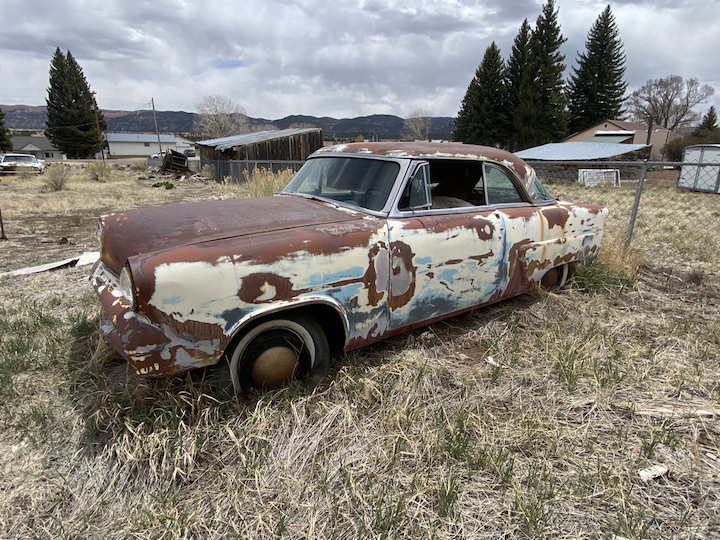
FORD (1953) — This 1953 Ford was discovered in Utah, one of 1,247,542 copies built that year making it one of the most successful cars in Ford history. Even at that number, Ford trailed Chevrolet by 99,000 units in '53. The full-sized Ford was refreshed for 1952 and carried over for 1953. The '52 model was the first Ford with a curved one-piece windshield. (Photo by Jim Prueter)
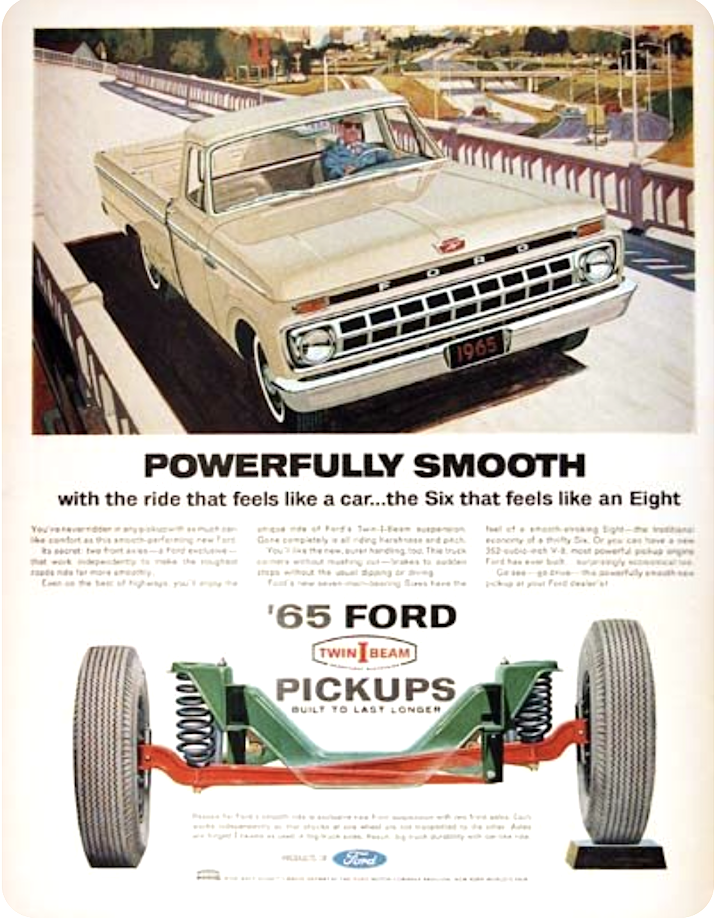
FORD (1965) — A 1965 Ford F-100 pickup with a camper shell rusts away in a farm shed in Johnston County, N.C. Ford introduced a dramatically new fourth-generation style F-Series pickup in 1961. Longer and lower than its predecessors, these trucks had increased dimensions and new engine and gearbox choices. They were built from 1961-1966. (Photo by Jim Meachen)

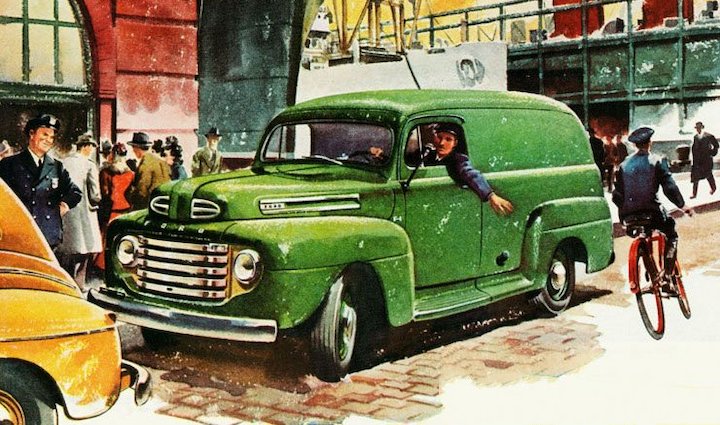
FORD (1948-1950) — The first Ford F Series trucks were built for the 1948 model year replacing trucks that were introduced in 1941. The original design F Series truck was built through 1950 before styling changes were made particularly with the grill and headlights. This 1948-1950 panel truck was discovered in Utah. (Photo by Jim Prueter)
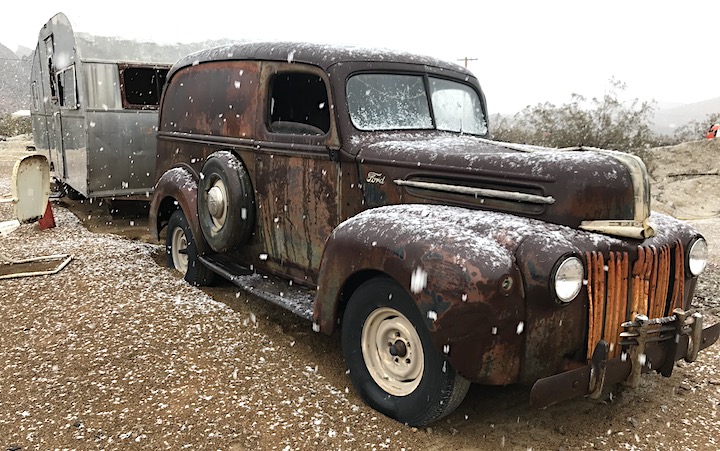
FORD (1946) — The 1946 Ford panel truck was a carryover from the 1942 truck, the last made before World War II. The panel truck was the vehicle of choice for small business before and after the war. The first post-war Ford panel truck was replaced in 1948 by a new F-Series truck. This '46 truck was found in Nevada hooked up to a travel trailer of the post-war era. (Photo by Jim Prueter)
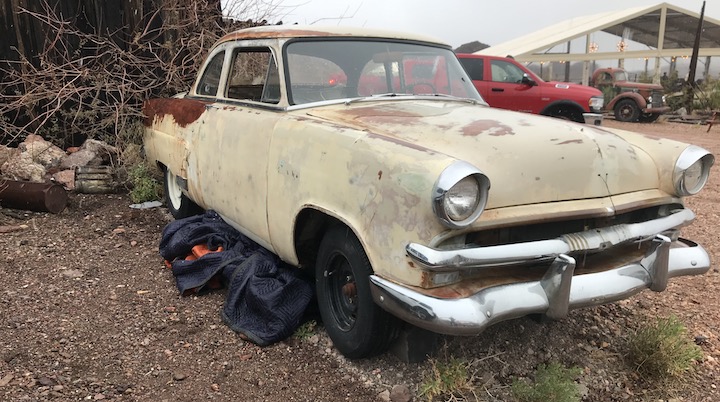
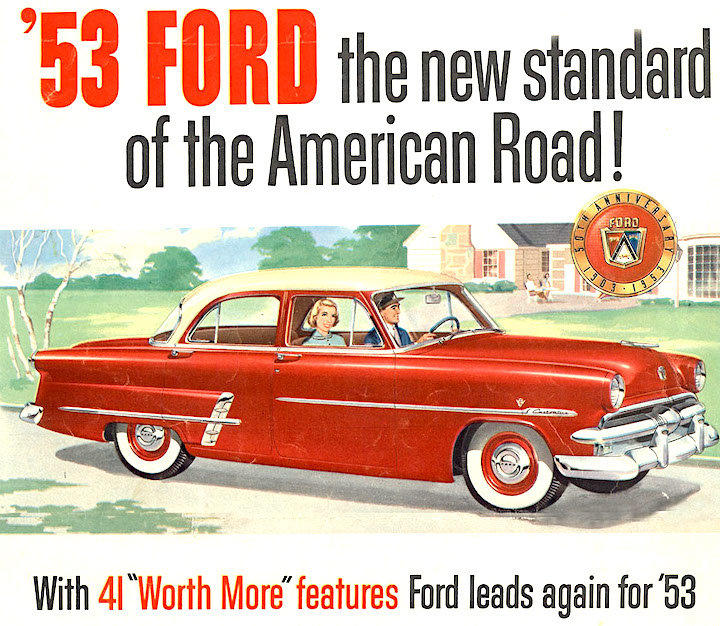
FORD (1953) — This 1953 Ford was found in retirement in Nevada. 1953 was Ford's 50th anniversary and the big news for 1953 was the availability of power-assisted brakes and steering, which had previously been limited to the Mercury and Lincoln lines. Ford sold 1,247,542 cars in 1953, trailing Chevrolet by about 99,000 units for sales supremacy. (Photo by Jim Prueter)
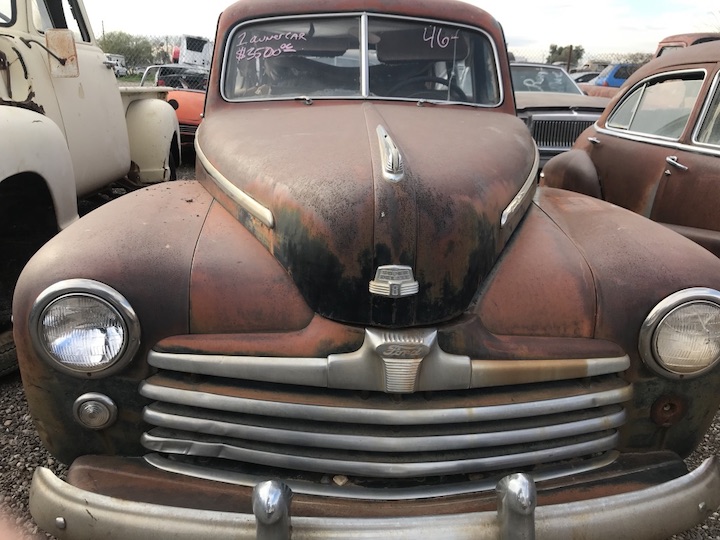
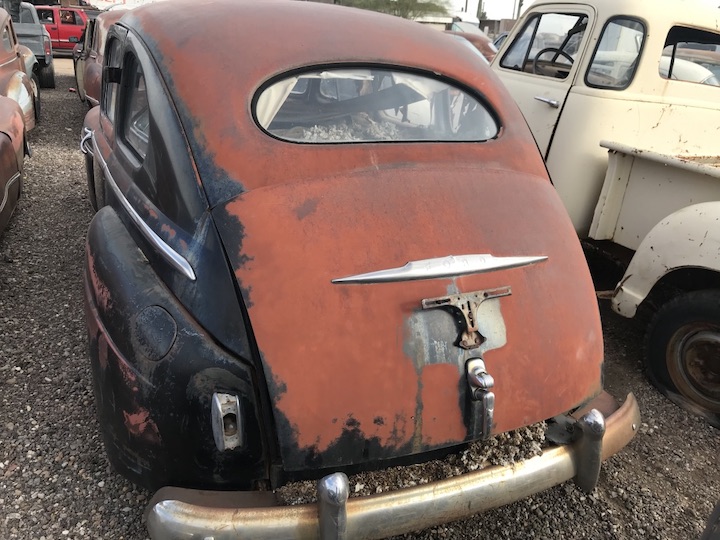

FORD (1946) An Arizona salvage yard was seeking $3,500 for this 1946 Ford when these pictures were taken. It looks as if it has a lot of useful parts for an automotive restorer. The Ford was totally redesigned for the 1941 model year and was carried over after the conclusion of World War II as a ’46 model, produced through 1948. Ford led all automakers by a wide margin in sales in 1946, outselling Chevrolet, 468,022 to 398,028. (Photos by Jim Prueter)
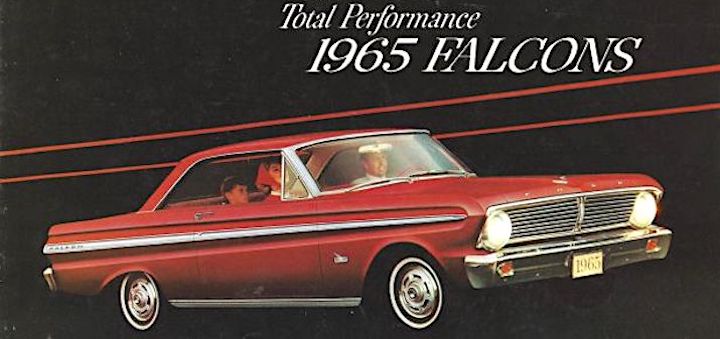
FORD (1965) — The Ford Falcon was produced from the 1960 to 1970 model years, the first compact car marketed by the American Big Three automobile manufacturers. This second-generation 1965 Falcon sits abandoned watching the traffic on a South Carolina road. Most second-generation Falcons were propelled by an inline 6-cylinder engine mated to a 3-speed automatic. (Photo by Ralph Gable)
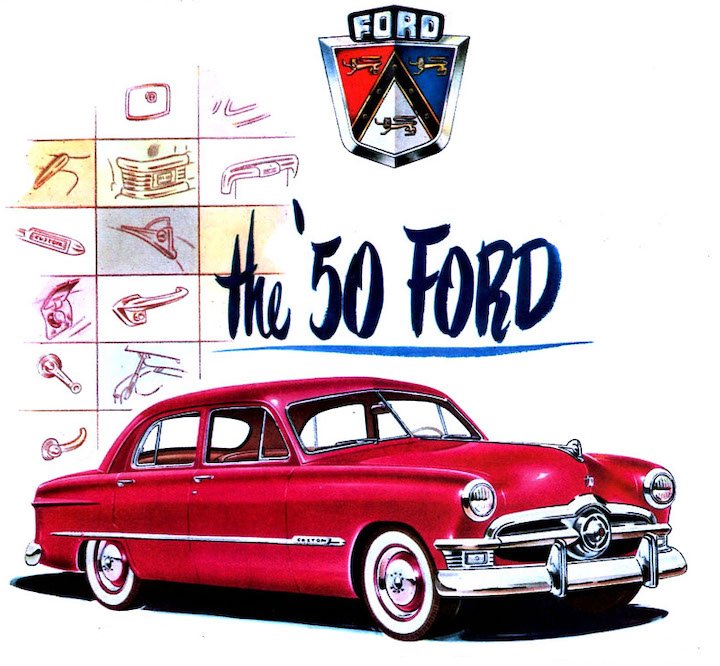
FORD (1950) — The 1950 Ford marked the second year of a new generation introduced following World War II. Two engines were offered in 1950 — a 3.7-liter L-head inline 6 and a 3.9-liter Flathead V-8 making 100 horsepower. Ford sold 1.2 million units in 1950, second behind Chevrolet that sold about 1.5 million cars. This used up example of a 1950 Ford two-door was found in Arizona. (Photo by Becky Antioco)
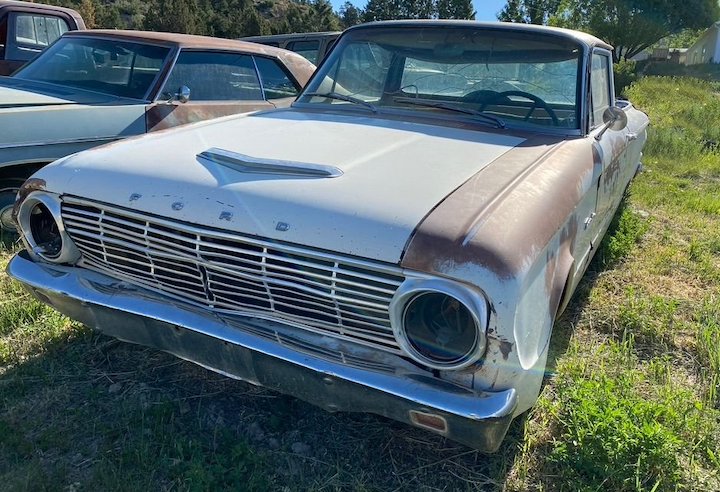
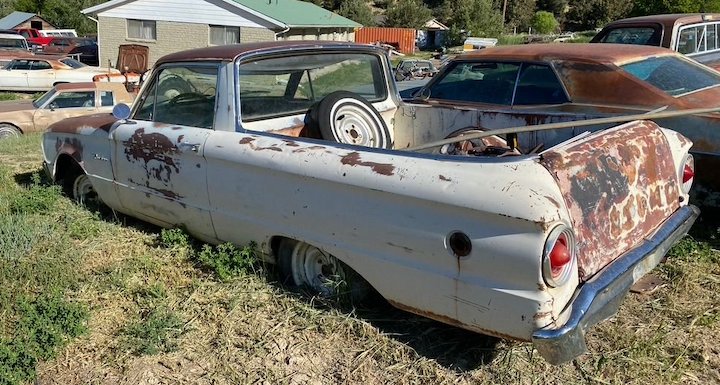
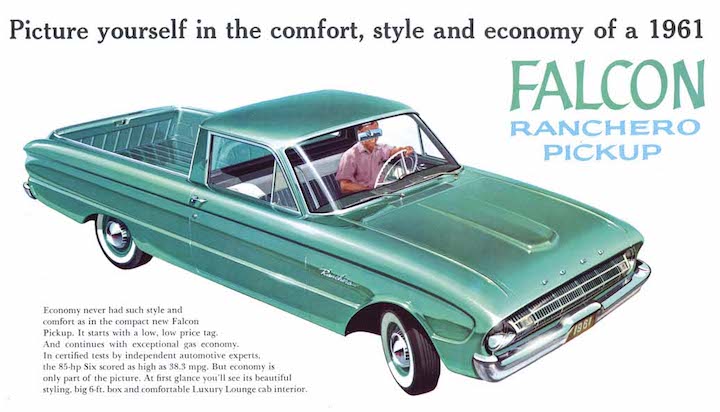
FORD (circa 1960) — This early second-generation Ford Ranchero pickup (1960-1965) was found living in retirement in Utah. The second-generation Ranchero was based on the newly introduced compact Falcon sedan. Ford believed the market wanted a more practical vehicle, one much smaller, lighter, and cheaper than a full-sized pickup truck, and indeed the Ranchero sold well. The standard engine was a 2.4-liter straight six with a 3-speed manual or a 3-speed Cruise-O-Matic automatic. (Photos by Jim Prueter)
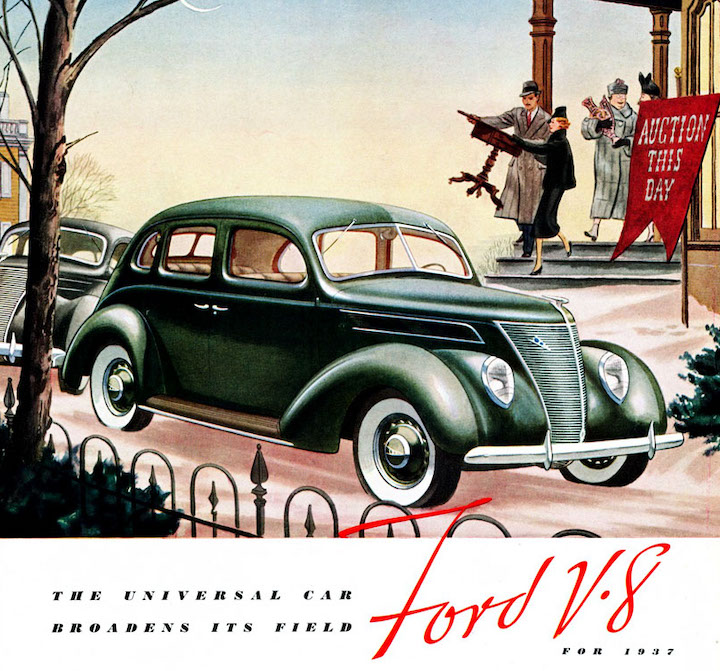
FORD (1937) — This 1937 Ford sedan was found along Route 66 in Holbrook, Ariz. The most popular Ford engine in 1937 was a 3.6-liter flathead V-8 making 85 horsepower with 144 pound-feet of torque. Base price of the 1937 was $850. Ford was the top-selling brand in 1937 with 942,005 copies sold. Chevrolet was second at 815,375. (Photos by Jim Meachen)
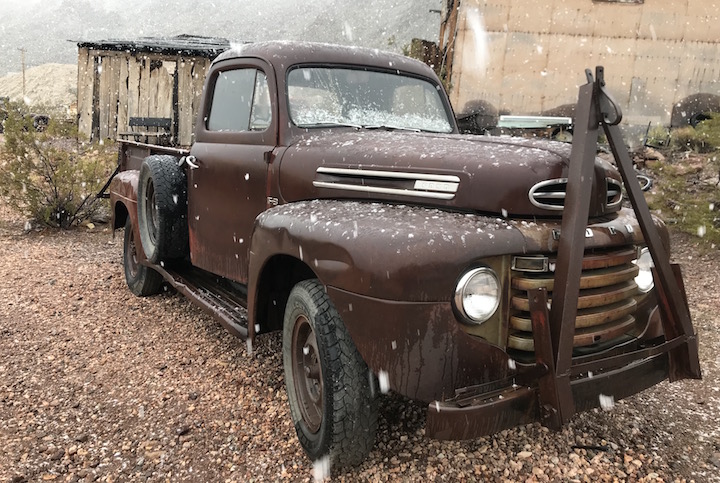
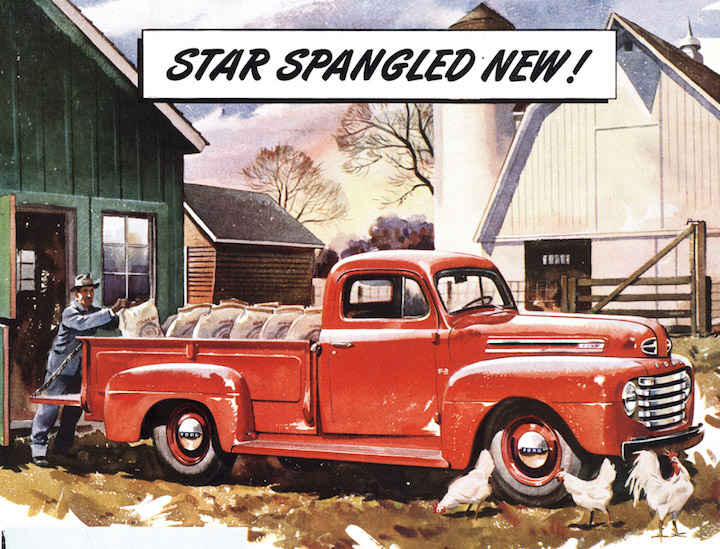
FORD (Circa 1948-1950) — Ford revealed its first post-WWII pickup truck in late 1947, introducing the first F-Series pickup for 1948, replacing trucks introduced before the war started in 1941. It had a flat one-piece windshield and integrated headlamps. The distinguishing feature of the first three years of the F-Series (1948-1950) was a grille with a series of horizontal bars. This circa 1948-50 truck found in Nevada was outfitted for some heavy duty work. (Photo by Jim Prueter)
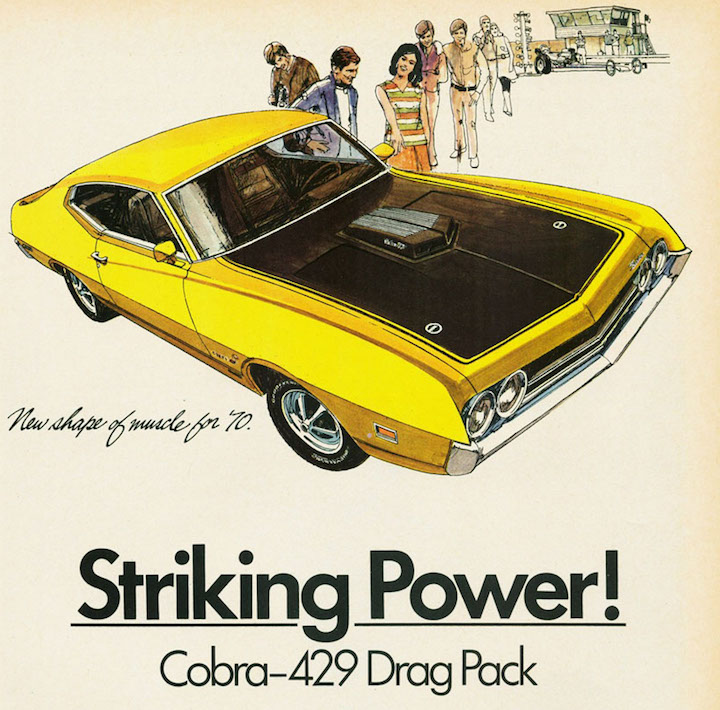
FORD (circa 1970) — The Ford Torino name was revived in 2008 wth Clint Eastwood's movie "Gran Torino," which focused on a retired guy and his restored 1972 Gran Torino in a Detroit neighborhood. Ford built the mid-sized fastback Torino from 1968 through 1976. This 1970 Torino sponsored by Long-Lewis Ford in Alabama apparently spent some of its life in stock car racing. (Photos by Ralph Gable)
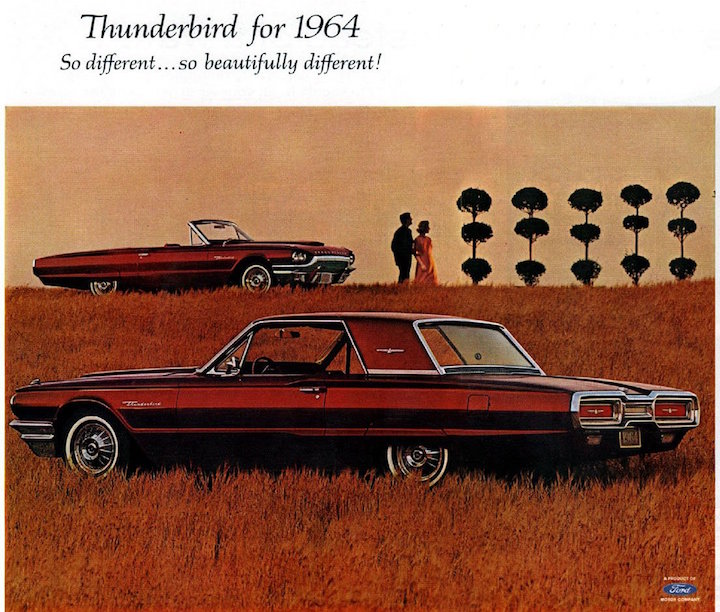
FORD (1964-1965) — This 1964/65 Ford Thunderbird was found in a yard full of old used-up cars on Route 66. We have for years thought the fourth-generation (1964-1966) the best designed four-place Bird in its long history. Its squared-off look moved away from earlier Thunderbirds. (Photo by Jim Prueter)
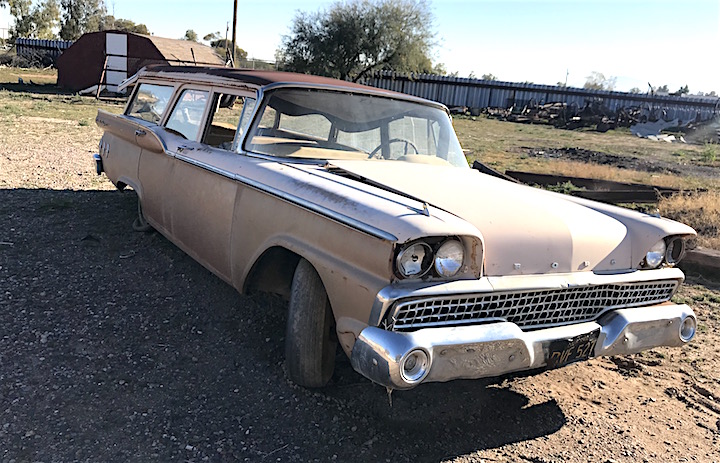
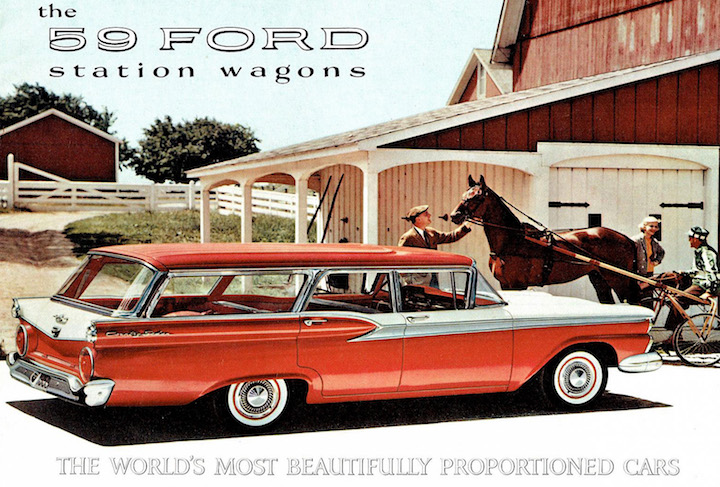
FORD (1959) The crossover of the 1950s, 60s, 70s and 80s was the so-called station wagon. One of the most popular was the 1959 Ford wagon that could carry up to nine people. Unlike today, manufacturers offered a full range of engines. For example, the '59 Ford could be purchased with five engine sizes ranging from an inline 6 making 145 horsepower to a massive 7.0-liter V-8 making 350 horsepower. Prices ranged from $2,565 to $3,075. This abandoned example was discovered in Arizona. (Photo by Jim Prueter)
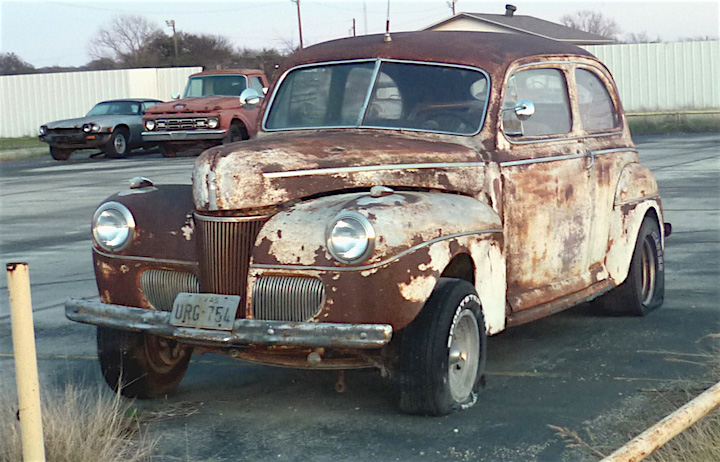
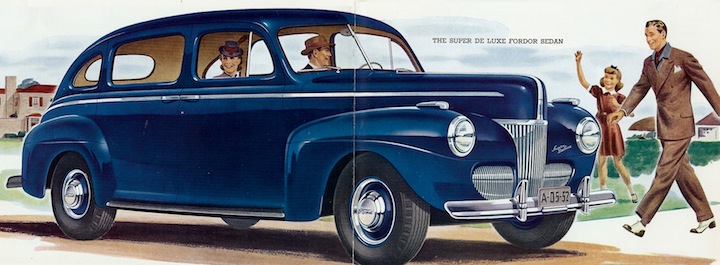
FORD (1941) — The Ford car was thoroughly updated in 1941, in preparation for a time of unpredictability surrounding World War II. The 1941 design would continue in an aborted 1942 model year and would be restarted in 1946 and produced until 1948. One unique feature was the "ignition key," which was actually used to operate a bolt lock on one end that unlocked the steering column — a feature destined to return, mandated, decades later — and on the other end unblocked the ignition switch, allowing it to be operated. The 1941 Ford was propelled by a choice of two flathead V-8s and an inline 6-cylinder engine. This example of the 1941 Ford was found in retirement in Texas. (Photo by Peter Hubbard)
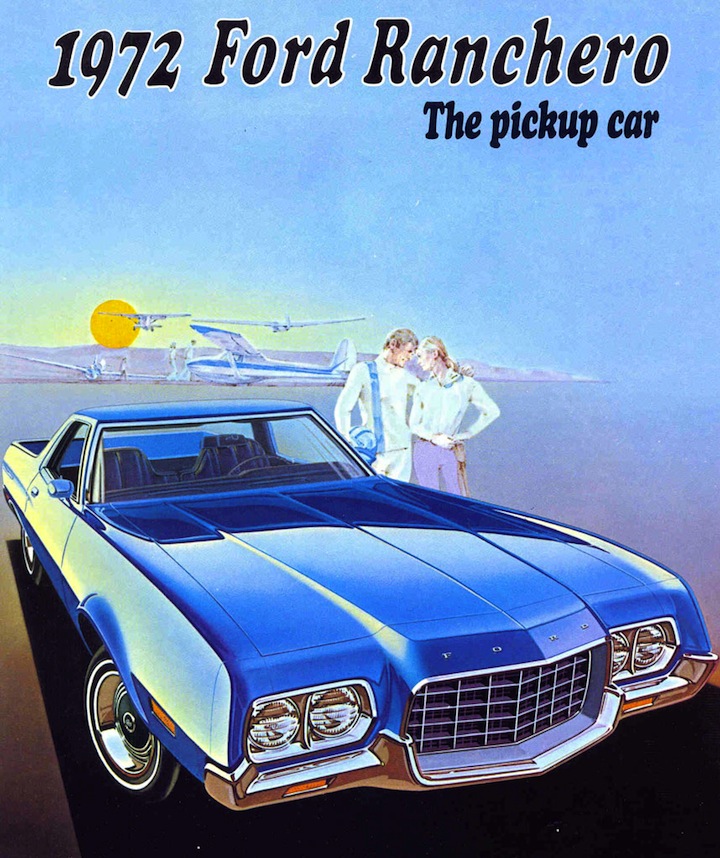
FORD (1972) — The fifth generation Ford Ranchero was built from 1972-1976, but the 1972 is a distinct — at least from the front — one-year model because the front of the 1973 was changed to meet federal crash-test standards. There were four engine choices including three V-8s in 1972. This "retired" copy was found in South Carolina. (Photo by Ralph Gable)
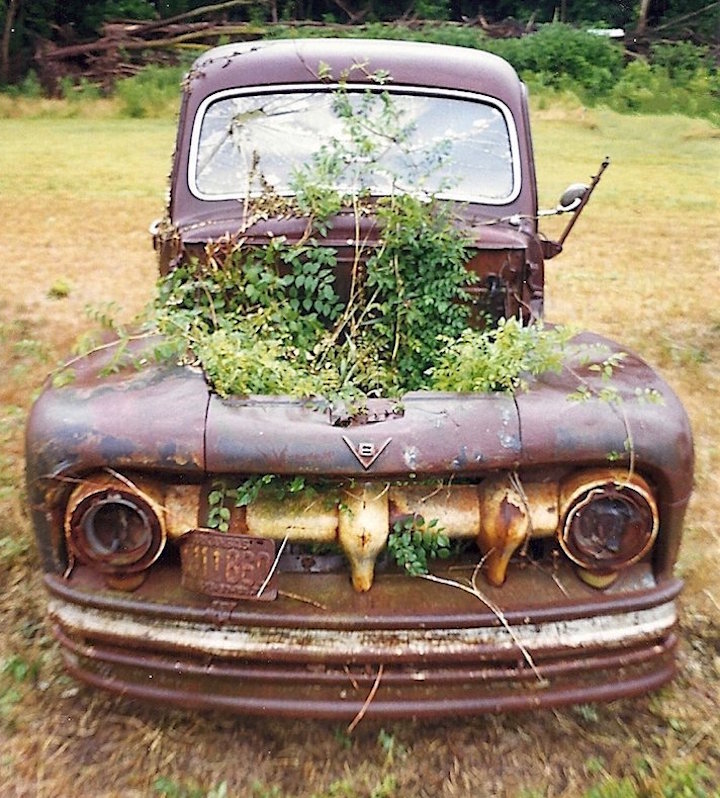
FORD (1951) — This 1951 Ford F-1 pickup was photographed near Atlanta, Texas, now serving as an outdoor planter. The first generation of the Ford F-Series pickup truck was built from 1948 through 1952. The standard pickup came in three formats including the F-1 (1/2 ton), the F-2 (3/4 ton) and F-3 Heavy Duty. The front end was redesigned for 1951 with a single-bar-type grille with a headlight at each end of the grille bar. (Photo by Peter Hubbard
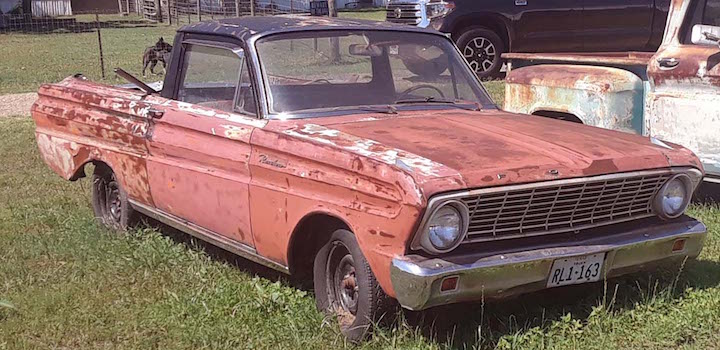

FORD (1964‚ — This 1964 second-generation (1960-1965) Ford Falcon Ranchero was discovered in Texas in what looks like restorable condition. The Ranchero was produced by Ford from 1957 through 1979 on various platforms including full-sized, compact and intermediate. The Ranchero was adapted from a two-door station wagon platform that integrated the cab and cargo bed into the body. A total of 508,355 units were produced during the model's production run. The second generation trucks came with a variety of engine sizes, the smallest being a 2.4-liter inline 6 making 90 horsepower. If performance was needed, there was a 4.7-liter V-8 available. (Photo by Peter Hubbard)
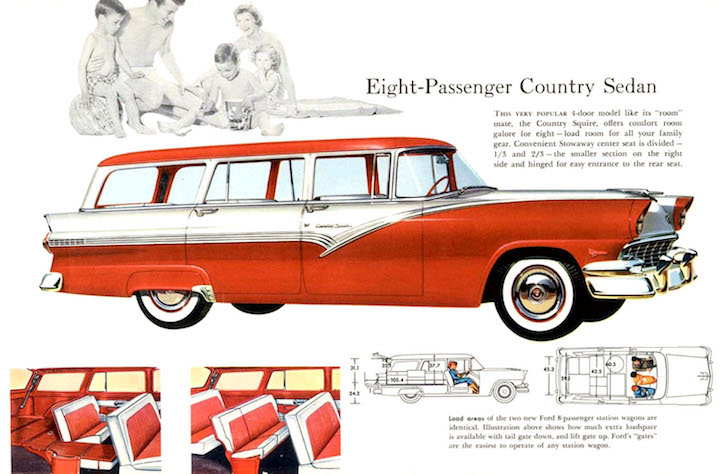
FORD (1956) — Station wagons were popular in the 1950s and Ford built six trim levels for 1956 from the base Custom Ranch Wagon through the luxurious Country Squire. This mid-trim level 1956 Country Sedan found in Rolla, Mo., could be purchased in an eight-passenger configuration. Like modern crossovers, rear seats could be folded down for cargo storage. The top engine for 1956 was the 292 cubic inch, 202-horsepower Thunderbird Y-8, which, Ford pointed out, used regular gas. (Photos by Jim Meachen)
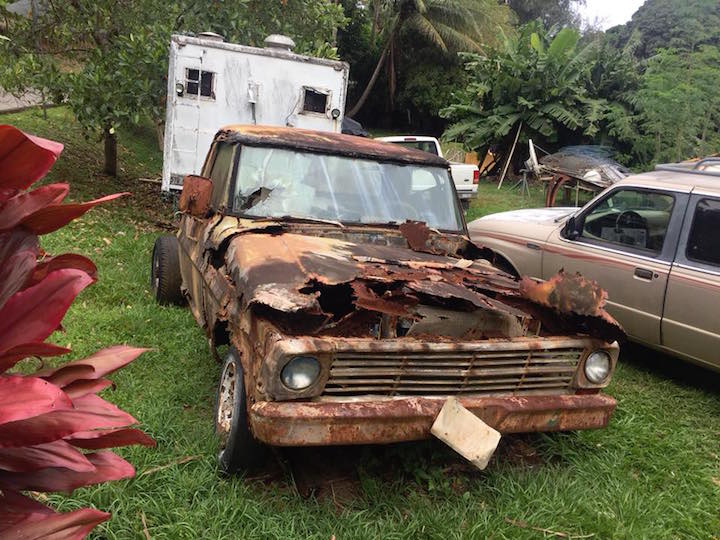
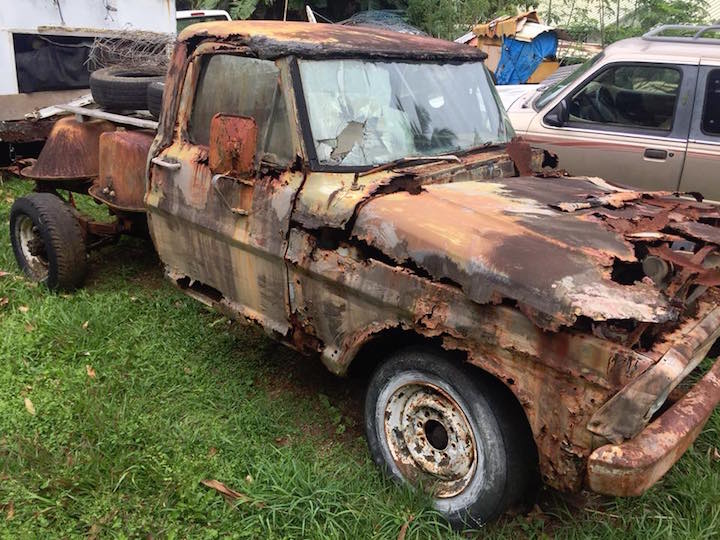
FORD (Late 60s) — This is one of the most rusted out abandoned vehicles we've ever encountered. The incredibly rust-laden late 1960s Ford truck was spotted near Kahaluu, Hawaii, by Jim Prueter. Prueter said he was told by a "reliable individual" the rust was created by the huge amounts of acid rain caused by the active volcano on the big island. No reason to doubt that analysis — the proof is in the Ford. (Photos by Jim Prueter)
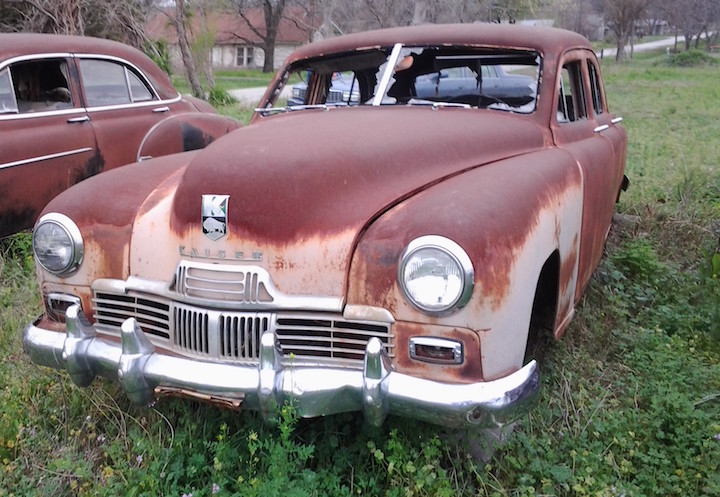
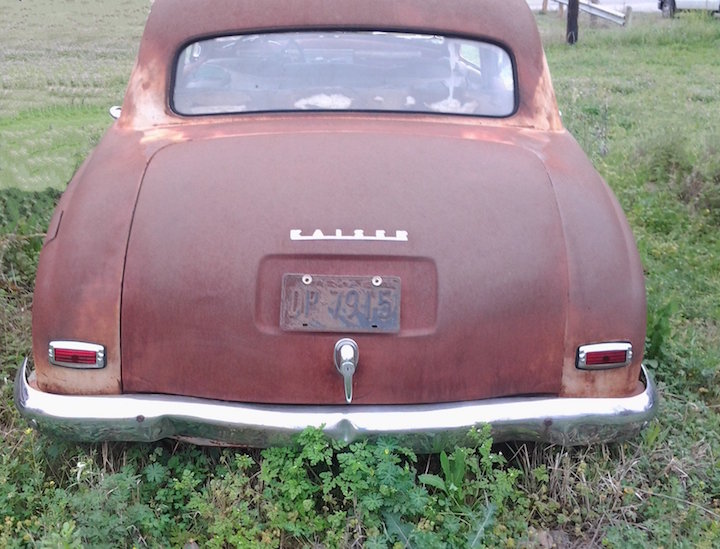
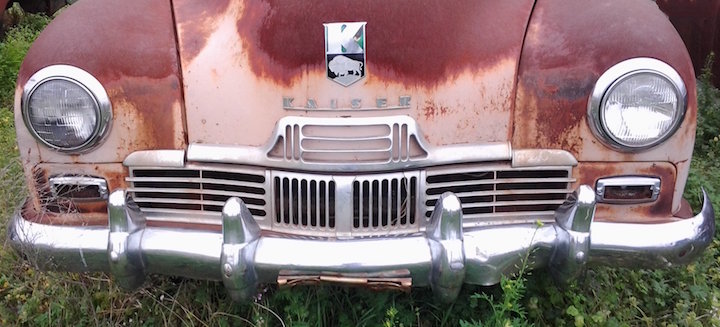
KAISER (1947-1948) — The Kaiser-Frazer Corp. began business in August 1945, and the Kaiser sedan was a fresh post-war design that enjoyed initial success to a nation starved for new vehicles. This copy — either a 1947 or 1948 model — was found in Texas. The front and rear of the car received a facelift for 1949. (Photos by Peter Hubbard)
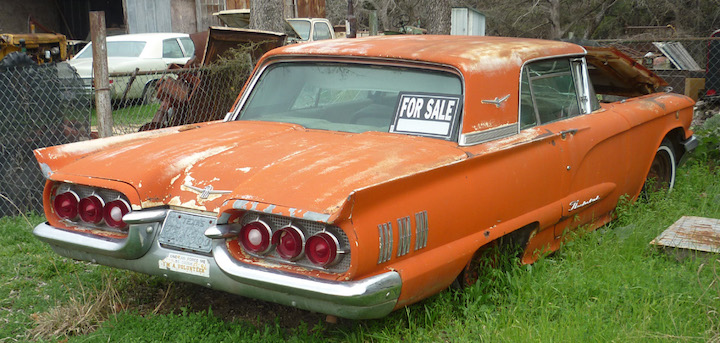
FORD (1960) — This 1960 Ford Thunderbird was spotted in Texas Hill Country, although we don't know if the well-used, but still restorable T-Bird was actually sold. Ford began building four-passenger Birds in 1958 after they started life three years earlier as a two-seat sports car. The 1960 model can be differentiated from the rear by its three taillights on each side. The 1958 and 1959 models had two. (Photo by Peter Hubbard)
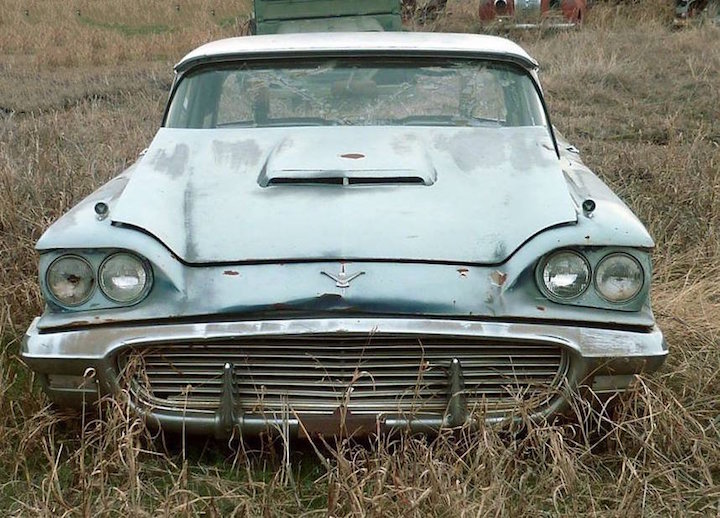
FORD THUNDERBIRD (1959) — After starting life as two-seat sports car in 1955, the Ford Thunderbird was turned it into a four-place "personal luxury car" for the 1958 model year. It was a sales success in the first years of its transformation. This rather beaten up 1959 model was discovered in retirement in a Texas field. (Photo by Peter Hubbard)
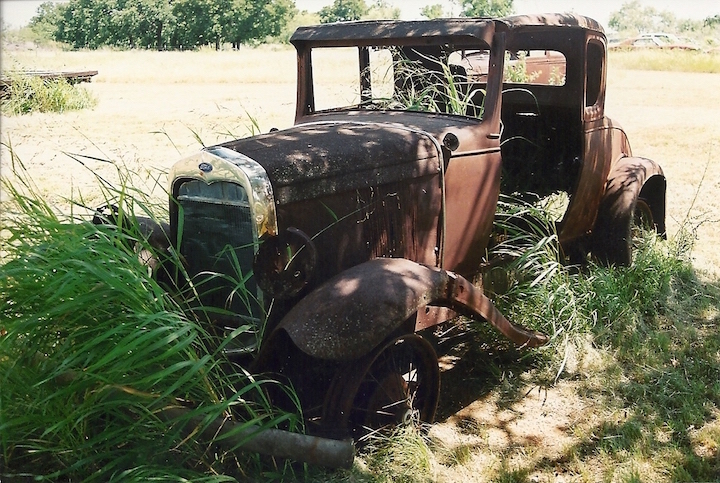
FORD (1928-19310) — Ford Model A, the successor to the historically successful Model T, was built for only four model years (1928-31), but sold nearly 5 million units in that short time. One copy — still barely surviving — was discovered by Peter Hubbard for his Junkyard Dog collection.
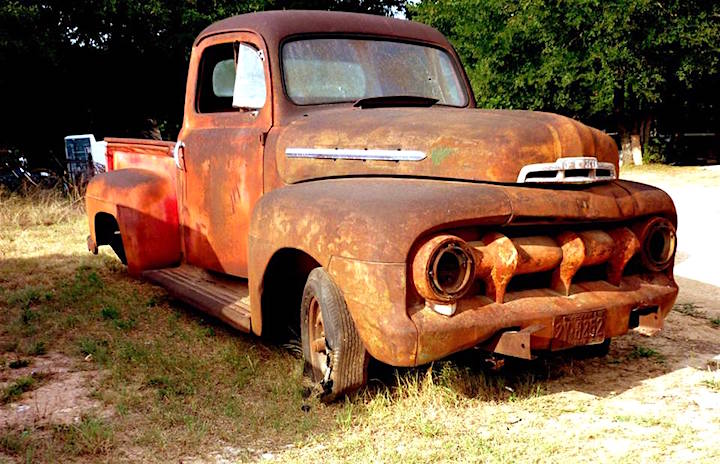
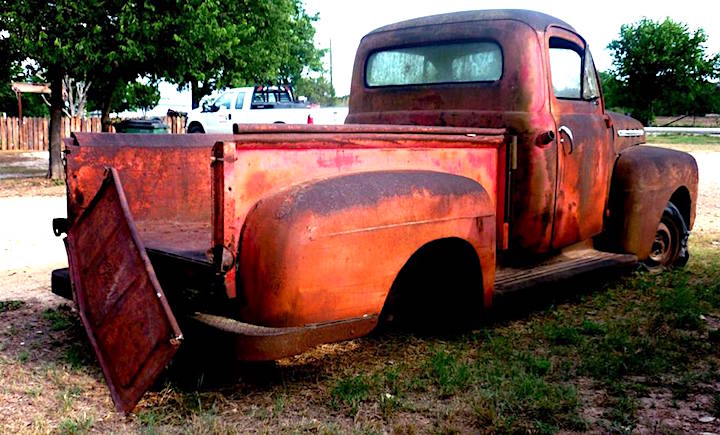
FORD (1951) — The first-generation Ford F Series pickup was introduced in 1948, and was built in eight different weight ratings and several different styles from 1948-1952. This 1951 sample was discovered by Peter Hubbard near Harker Heights, Texas. (Photos by Peter Hubbard)
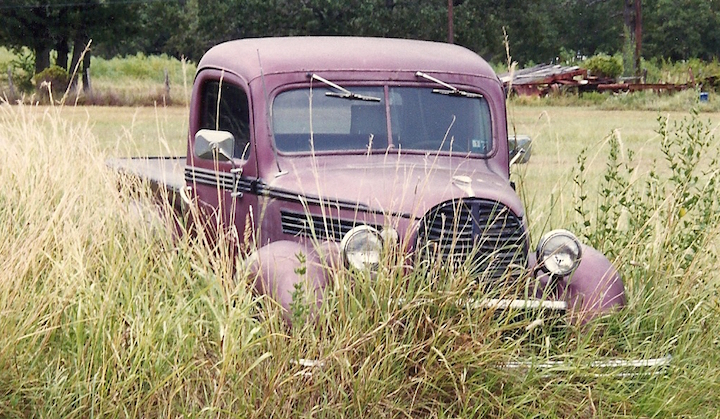
FORD (1938) — This 1938 Ford pickup from Peter Hubbard's Junkyard Dog collection was found in a large vintage salvage yard near Tokina, Ill., with dozens of other cars and trucks, mainly from the '50s. The truck could be purchased with two flathead V-8 engine sizes — a 2.2-liter making 60 horsepower and a 3.6-liter rated at 85 horsepower. All trucks were equipped with a 3-speed manual transmission. A radio was a $45 option — plus installation charge. (Photo by Peter Hubbard)
FORD (late '40s) — This late-1940s Ford F-Series pickup is serving its retirement years as a roadside sign along old Route 66 in Oklahoma. The first F-Series was introduced in late 1947 as a 1948 model replacing the pre-WW II designed trucks. The first generation was built through 1952 and good be purchased wth an inline 6-cylinder engine, a Flathead V-8, or a Y-block V-8. (Photo by Jim Meachen)
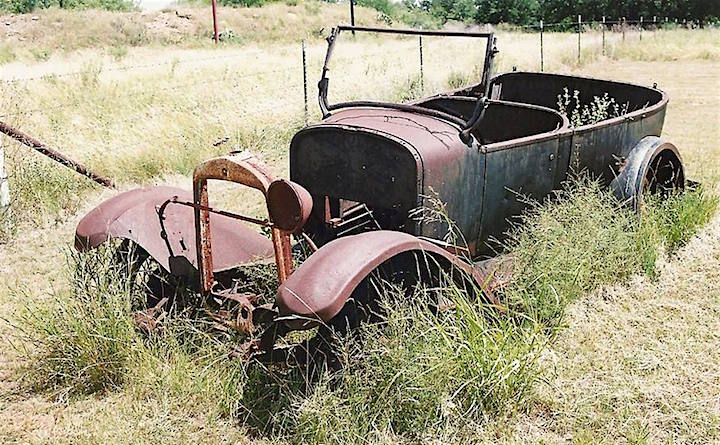
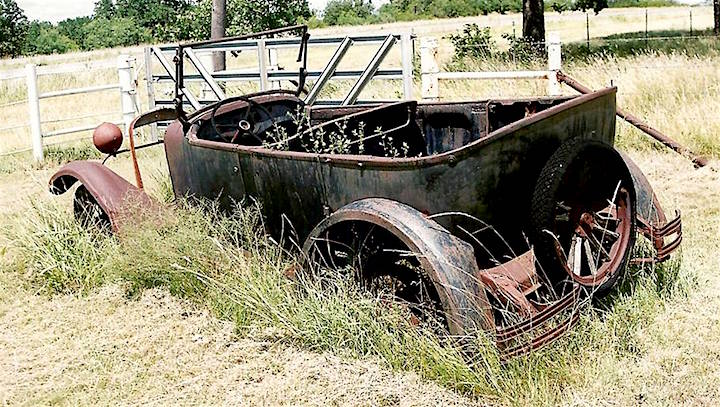
FORD (Model A) — Ford sold nearly 5 million Model A's during the five years of its production run from 1927 through 1931. We think this is one of those millions discovered near Cisco, Texas. The shell of a car is hard to identify, but it has all the characteristics of the Ford. (Photos by Peter Hubbard)
FORD (1964) — The compact Ford Falcon featured a more squared-off look for 1964, the first year of its second-generation. The '64 Falcon came in eight body styles and with five engine offerings (three inline 6-cylinder models and two V-8s). Transmissions included a two- and three-speed automatic and a three- and -four-speed manual. This abandoned copy was found in Rolla, Mo. (Photos By Jim Meachen)
FORD (1940) — This rusted-out 1940 Ford work truck was discovered at the Wigwam Motel along old Route 66 in Holbrook, Ariz. (Photos by Ted Biederman)
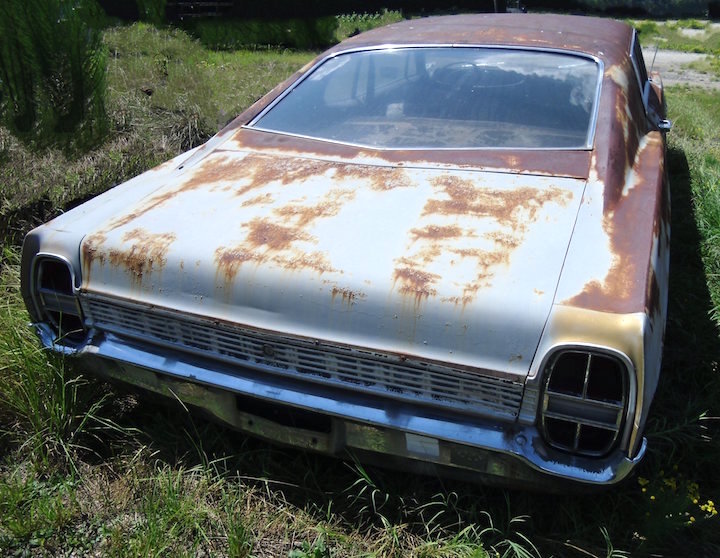
FORD (1968) — The Ford Galaxie was a full sized sedan built from 1959 through 1974. The third generation ran from 1965 through 1968 with the 1968 model getting a new grille and headlights arranged horizontally. This rusted 1968 model — in otherwise good condition — was found in retirement in South Carolina. (Photos by Ralph Gable)
FORD (1963) — This 1963 Ford Galaxie convertible was discovered in Cuba, Mo. The Galaxie name was applied to all of Ford's full size models in 1962. The 1963 model marked the third year of the 1960-1964 design, although exterior styling was altered in each year. Several engines were offered all mated to a three-speed automatic. (Photos by Jim Meachen)
FORD (circa 1948-1952) — The original F-Series Ford pickup was built from 1948 through 1952. A well-preserved copy was spotted doing service as yard art at a home near Seattle, Wash. (Photo by Jim Meachen)
FORD (1970) — This large 1970 Ford Thunderbird was spotted in a South Carolina salvage yard by Ralph Gable. The four-door Thunderbird stretched out 215 inches with a wheelbase of 117.2 inches. Curb weight was 4,464 pounds. The standard engine was a 429 V-8 making 360 horsepower mated to a 3-speed automatic transmission. Notice this fifth-generation model used suicide doors. (Photo by Ralph Gable)
FORD (1962) — Ford restyled the Thunderbird in 1961 to kick off the third generation (1961-63). Sales of the new Bird were strong in 1961 with 73,051 sold. Most T-Birds were powered by a larger 6.4-liter V-8. This 1962 edition was spotted in an abandoned condition in eastern North Carolina. (Photos by Ralph Gable)
FORD (circa 1961-62) — Ford introduced its fourth generation F-Series pickup in 1961, a longer and lower version of the third generation with new engine and gearbox choices. This circa 1961-62 pickup was found in restorable condition in Cuba, Mo. (Photos by Jim Meachen)
FORD (1966) — This 1966 Ford Mustang resides on the side of a South Carolina road hoping someone will come along and give it the restoration it deserves. While the exterior seems to be in good condition, it will take some work and greenbacks to bring the interior back up to acceptable standards. (Photos by Ralph Gable)
FORD (1977-79) — This circa 1977-79 Ford Ranchero has been abandoned in an abandoned small town on old Route 66 in Arizona. The Ranchero rests near one of the abandoned buildings. Several "ghost towns" can be found along Route 66 created after the interstate highway system made the old highway obsolete. Ford built the Ranchero from 1957 through 1979 based on a variety of vehicles. The seventh and last generation (1977-79) was based on the Ford LTD II car line. Above: An advertisement for the 1977 Ranchero. (Photo by Ted Biderman)
FORD (1961) — This 1961 Ford Galaxie Sunliner was discovered in Missouri. Ford gave the car a cleaner look for 1961 with tailfins nearly gone and the with the addition of two giant circular taillights. A new 6.4-liter "Thunderbird" V8 was added to the lineup, making a claimed 401 horsepower, mated to a 3-speed Cruise-O-Matic transmission. (Photos by Jim Meachen)
These Ford vehicles were found in retirement in eastern North Carolina. At right, a 1961-63 era Thunderbird rests next to a mid-60s era Ford pickup. (Photo by Ralph Gable)
FORD (1946) — The first post-World War II Ford came off the assembly line in July 1945 as a 1946 model. Ford was throughly updated in 1941 before production was halted in 1942 for the war, and the 1946 was a continuation of the '41 model. An all-new Ford was introduced in 1949. This 1946 Ford was found in North Dakota. (Photos by Jim Meachen)
FORD (1955/56) — Ford received a new body style for 1955 and a new top-of-the-line model, the Crown Victoria, replacing the Crestline. The Crown Victoria featured a chrome "basket handle" across the hardtop roof. This styling feature was used to visually separate the front of the passenger compartment from the rear. This 1955 or 56 Crown Vic — with its signature chrome warp-around feature — was discovered in a truly abandoned state of decay in eastern North Carolina. (Photos by Jim Meachen)
FORD (Model A) — The Ford Model A was produced from October 1927 through 1931, replacing the aging Model T, which was sold for18 years. Prices for the Model A ranged from $385 to $1,400. Nearly five million were made in that short span of time. This Model A — in restorable condition — watches life go by on the side of a highway. (Photos by Ralph Gable)
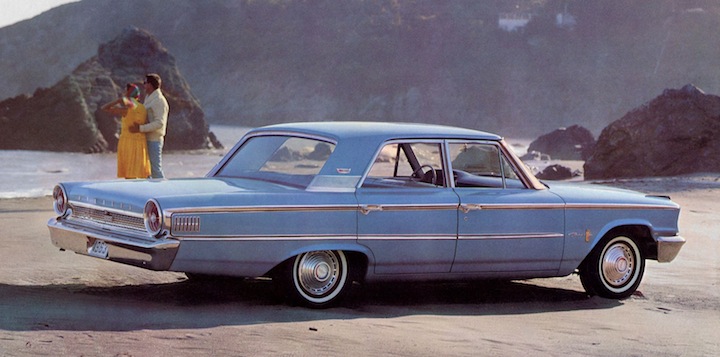
FORD (1963) — This 1963 Ford Galaxie was found in South Carolina in retirement in someone's yard. The Galaxie was a full-sized car built in the U.S. between 1959 and 1974. The name was used for the top models in Ford's lineup through 1961. The '63 model was essentially unchanged from the 1961-62 models except from some freshening and added trim. Also pictured, an advertisement for the '63 Galaxie. (Photos by Ralph Gable)
FORD (1963) — This 1963 Ford Falcon was the last model of the first-generation (1960-1963) Falcon built by Ford. The compact-sized Falcon was initially a hit with more than a half million sold each of its first two years of existence. This well preserved model was found in South Carolina. (Photo by Ralph Gable)
FORD (1969) — The top-of-the-line 1969 Ford Galaxie XL was built on a new 121-inch wheelbase and came with Ford's new 7.0-liter Thunderjet V-8 making 360 horsepower in the 4-barrel carburetor version. This used up Galaxie convertible was discovered by Abandoned Cars and Trucks photographer Ralph Gable.
FORD (1961-63) — This third-generation (1961-63) Ford Thunderbird was found in an abandoned state in North Carolina. A 6.4-liter 390 cubic inch V-8 mated to a three-speed automatic transmission was the base powertrain. The third generation benefited from product placement on TV, most notably on the popular series "77 Sunset Strip." (Photos by Ralph Gable)
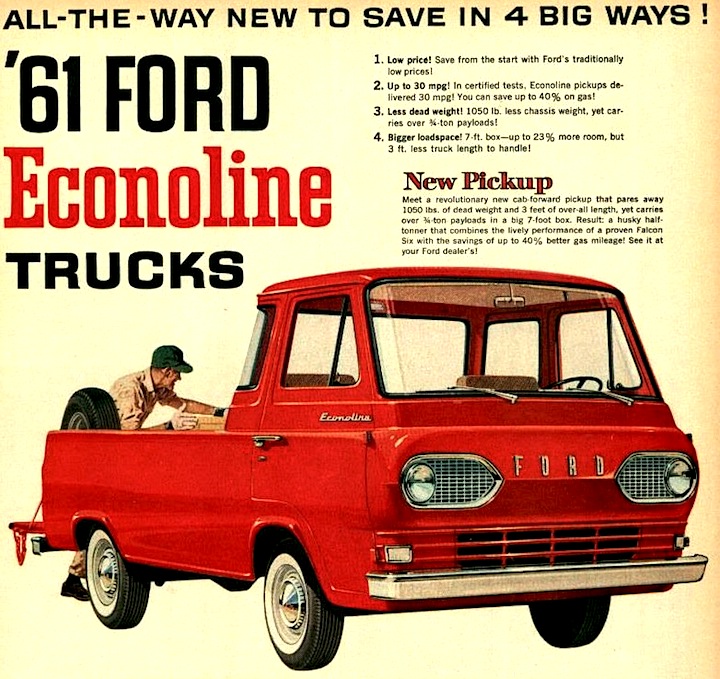
FORD (early 60s) — This early 1960s Ford Econoline pickup truck was spotted in Cuba, Mo. Based on the compact Ford Falcon, the first Ford Econoline utility van and pickup was introduced to the public on Sept. 21, 1960 for the 1961 model year. The design put the driver on top of the front axle with the engine near the front wheels, called "cab over." Early models sported a 144 cubic inch (2.4 L) inline 6 engine with a three-speed manual transmission. (Photos by Jim Meachen)
FORD (1948-1950) — Ford has built the F-Series pickup truck since 1948, the first generation produced from 1948 through 1952. It was the first post-war truck design from Ford and marked a big change from a pickup based on a car chassis to a pickup built on a dedicated truck platform. This example of the first F-Series (circa 1948-50) is still in use — as yard art at a home near Seattle, Wash. (Photos by Jim Meachen)
FREIGHTLINER (1960s era) — A 1960s-era Freightliner cabover is slowly being overtaken by bushes as it rests in retirement. Freightliner trucks have been built since the 1940s and are currently owned by Daimler Trucks North America. (Photo by Ralph Gable)
FORD (1941) — Based on a quick read of the internet, a 1941 Ford convertible in restored condition can bring as much as $35,000 — and beyond. And some people are even attempting to sell body shells for close to five figures. So this stripped out and worn out copy of a pre-war convertible discovered by photographer Ralph Gable may be worth some bucks.
FORD (1959) — The 1959 Ford was a major refreshening of the Ford generation that started with the 1957 model. It was perhaps Ford's attempt to counteract the soon-to-be-released all-new "bat-fin"1959 Chevrolet. Although conservative in appearance to the new Chevy, the Ford and its top-of-the-line Galaxie — introduced for the first time — proved to be a popular vehicle. This lower trim version Ford Custom 300 rusts away in a North Carolina salvage yard. (Photo by Ralph Gable)
FORD (circa 1966-1977) — The Ford Bronco sport utility vehicle hit the market in 1966 and was built mostly unchanged through 1977. The original Bronco, labeled an ORV (Off-Road Vehicle), was designed to compete against the Jeep CJ. The initial engine was a 2.8-liter straight six. Five generations of the Bronco were built through the 1996 model year. This early Bronco has been stripped of most of its equipment inside and out. But the body appears in relatively good shape. (Photos by Jim Meachen)
FORD (1969) — A once-vibrant 1969 Ford Mustang has been cannibalized and left to be slowly dissolved into the weeds and scrub bushes. The1969 edition was the first model to use quad headlamps placed both inside and outside the grille opening. Ford offered a variety of engines in the '69 from the 3.3-liter I6 to the rumbling 429 cubic inch Boss V-8. Nearly 300,000 Mustangs were manufactured in 1969, a steep drop off from the 607,558 built for the peak year of 1966. (Photos by Ralph Gable)
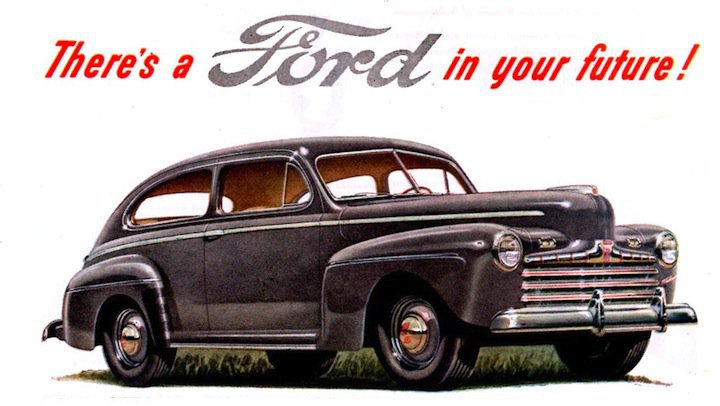
FORD (1946) — Ford retained the basic design of its 1942 model when it got back into production in 1946 following the end of World War II. One of the few changes was to the grille, a series of horizontal bars. The 1942 Ford had a vertical bar design. And Ford eliminated its low-priced Special sixes, which left it with six- and eight-cylinder DeLuxe and Super DeLuxe models. This 1946 Ford two-door patiently waits beside a road for someone to rescue it from abandonment and neglect. Notice someone has changed out the original hood ornament for a 1950's model. (Photos By Ralph Gable)
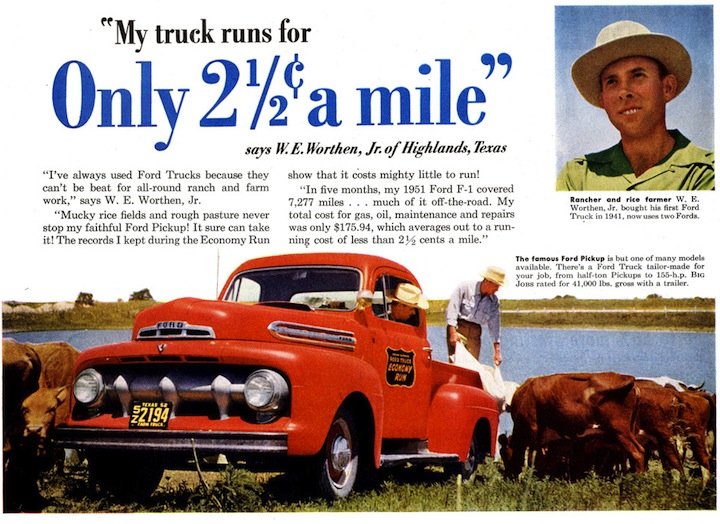
FORD (1951) — This early 1950s Ford pickup was found in an abandoned condition enjoying retirement in the beautiful North Carolina mountains. Above, a magazine ad for the new 1951 Ford pickup touting its gas mileage. (Photo by Jim Meachen)
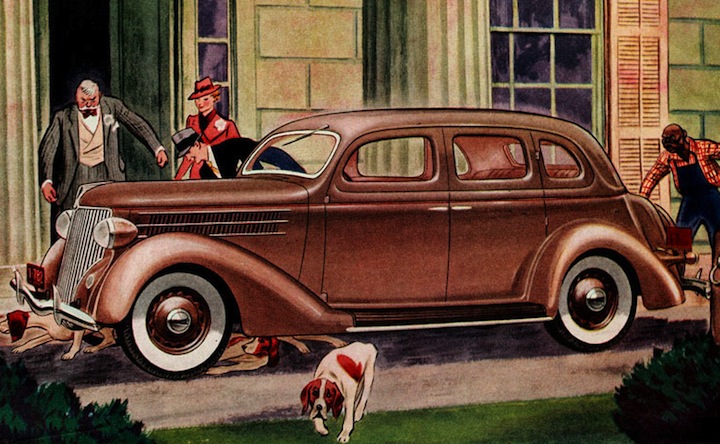
FORD (1936) — This 1936 Ford four-door sedan has been picked clean with just the shell and the remnants of its V8 engine block remaining. The V8 was the standard engine offering for Ford cars in 1936. The mid-30s Fords were very popular and ran neck-and-neck with Chevrolet for the title of "best selling car." Above is a rather interesting magazine ad for the '36 Ford. (Photos by Jim Meachen)

FORD (1941) Ford was thoroughly updated for 1941 with a new look including a three-piece grille. There were three car lines — Special, De Luxe and Super De Luxe. A new entry-level engine was added to the lineup, a 3.7-liter straight 6 developing 90 horsepower. The popular 2.2-liter flathead V-8 continued as the top-line engine. This used-up 1941 Ford was found in South Carolina. (Photo by Ralph Gable)
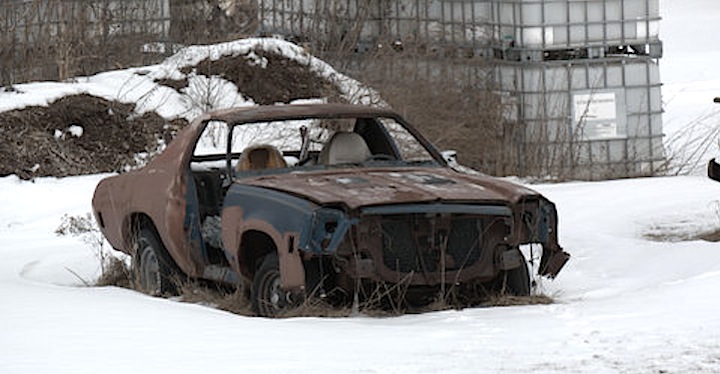
FORD — What looks like a mid-70s Ford Mustang lives in the Wisconsin snow stripped of most of its exterior features including the doors. (Photo by Jerry Brown)
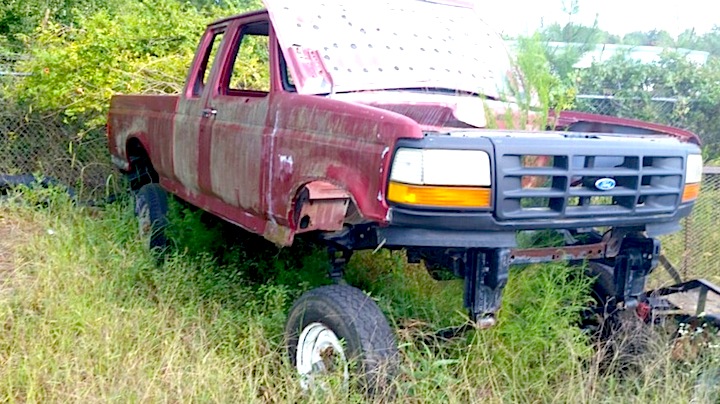
FORD — This early '90s model Ford F-150 may be gratified that it has been put out to pasture, stripped of most of its necessary parts, after it was horribly desecrated in the last years of its useful road life. (Photo by Ralph Gable)
FORD (1970s) — This sixth generation (1973-1979) Ford F-350 tow truck has apparently seen its final duties as it sinks into the ground in eastern North Carolina. (Photos by Jim Meachen)
FORD (1964/65) — Three generations of the compact Ford Falcon were built from 1960 through 1970. The Falcon was given a more squared-off appearance for the second generation (1964-65). This second generation Falcon was found in neglected condition in North Carolina. The new Mustang was based heavily on the Falcon's unitized frame design. It could be ordered with three variations of the inline 6 and with three V-8 engines, the biggest a 302 cubic inch (4.9 liter). (Photos by Ralph Gable)
FORD (1967) — This 1967 Ford Fairlane looks restorable. The fifth generation Fairlane was revised in 1966 to match the full-sized Ford, which was restyled in 1965. The front end was highlighted by vertically stacked headlights. The Fairlane received a minor facelift in 1967. The top-selling engine both years was the 289 cubic inch V-8, referred to as the 289. The GT model, such as the one pictured, had a more muscular 390 cubic inch V-8 making 335 horsepower.1966-67 were the only two models years of the fifth generation before another redesign ushered in the sixth generation. (Photos by Ralph Gable)
FORD (1947) — This 1947 appears in very restorable condition. It was discovered awaiting some restoration help in eastern North Carolina. (Photo by Ralph Gable)
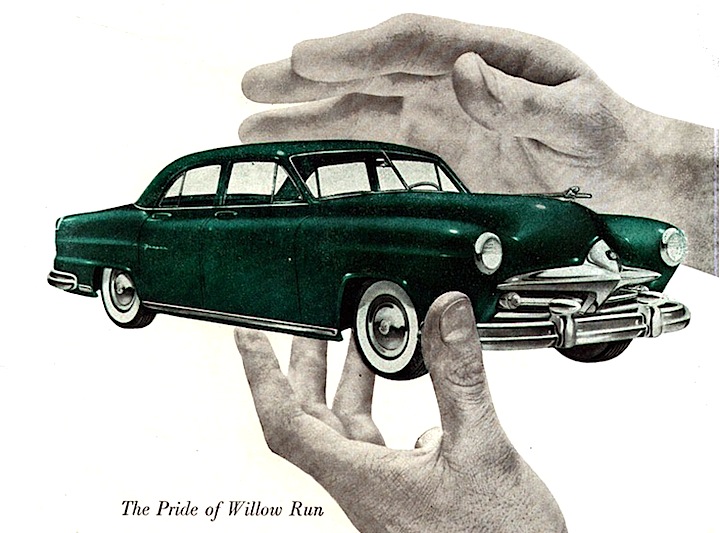
Frazer, which was built from 1946 through 1951, was the upper-medium priced luxury car from the Kaiser-Frazer Corp. It was restyled for 1951 and included a four-door convertible, a hardtop sedan and a unique hatchback sedan. This 1951 example was found in restorable condition. Above, a 1951 magazine ad. (Photos by Jim Meachen)
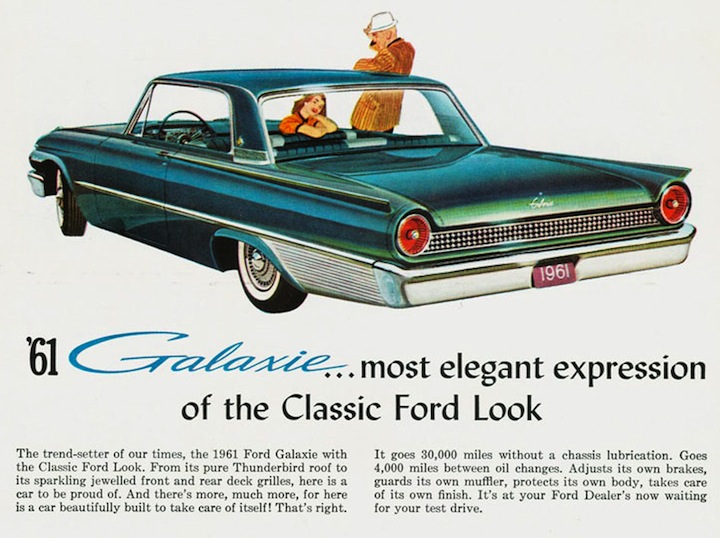
FORD (1961) — Ford was restyled for the 1961 model year with a new grille, a squared off roofline and new round taillights. This example was found in Florida in a deteriorating condition. Above is an ad for the Ford Galaxie. (Photo by Ralph Gable)
FORD (1957) — This 1957 Ford has probably been for sale for a considerable amount of time based on its condition. The Ford sedan was spotted along the side of a road in rural Kentucky south of Cincinnati. The full-size Ford was restyled for 1957 and came with six engine choices — a 3.7-liter inline 6, and 4.5-liter, 4.8-liter, 5.1-liter, 5.4-liter and 5.8-liter V-8s. Transmission choices were a three-speed manual or a two-speed or three-speed automatic. (Photos by Jim Meachen)
FORD (1951) — This rather dilapidated 1951 Ford was found by the side of a North Carolina highway. In 1949, Ford came out with its first all-new design since World War I, and the first all-new design by the so-called Big Three U.S. auto companies. The new streamlined design, which was produced through the 1951 model year, featured such changes as integrated rear fenders. In 1951 Ford offered an automatic transmission for the first time, the Ford-O-Matic. The '51 Fords were powered by either a 3.7-liter inline 6 or a 3.9-liter flathead V-8 making 100 horsepower. (Photos by Ralph Gable)
FORD (1965) — A first-generation Ford Mustang sits in abandonment in North Carolina perhaps awaiting rescue by someone looking for a good restoration project. Ford sold nearly 419,000 Mustangs in its first year of production from April 17, 1964, through April 17, 1965 — and the rest is history. (Photos by Ralph Gable)
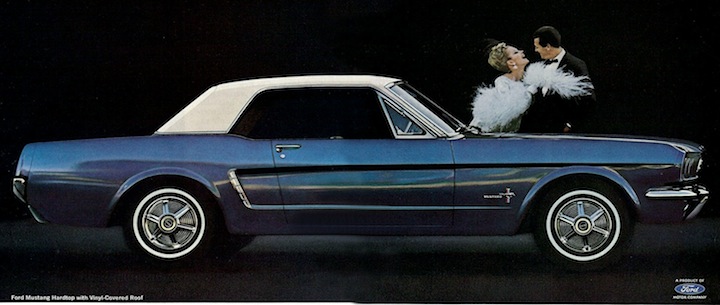
FORD (mid-80s) — This copy of a ninth-generation (1983-1988) Ford Thunderbird seems to be in restorable condition. After lackluster sales of the eighth generation, Ford designed a sleeker Bird for the mid '80s. Two engines were carried over from the eighth generation, a 3.8-liter V-6 and a 4.9-liter V-8. A 2.3-liter 4-cylinder turbo was added to the lineup in 1983. (Photos by Ralph Gable)
FORD (1946) — A 1946 Ford that once served as a roadside advertisement for a business lies in decay in eastern North Carolina. The '46 was basically a carryover from the 1942 model, the last made before production stopped for World War II. Outside trim was nearly identical to the 1942 except for the new horizontal grille consisting of three stainless steel bars. (Photos by Jim Meachen)
FORD (mid 60s) — A mid-60s Ford F-850 commercial truck is camouflaged in the woods near Chapel Hill, N.C., its work life long over. (Photo by Ralph Gable)
FORD (1964) — A 1964 Ford Galaxie 500 convertible rests in the North Carolina sunshine missing its top, a wheel, and taillights. The Galaxie was Ford's top-of-the line full-sized model from 1959 through 1974. (Photos by Jim Meachen)
FORD F-150 — This 1980s era Ford F-150 has become a planter of sorts with a tree growing out of what once was the bed of the truck. Seems the tree, along with other vegetation, has grown quite attached to the retired pickup. (Photos by Jim Meachen)
FORD (1965) — Ford built the Ranchero from 1957 through 1979, a vehicle with a cargo bed integrated into a car body combining the looks of a sedan and the utility of a light duty pickup. This 1965 model was based on the compact Ford Falcon. The 1957 through 1959 models were based on the full-sized Ford platform before Ford moved the Ranchero to the smaller Falcon platform in 1960. This 1965 model was spotted along with a multitude of other used up cars in the hill country of Texas. (Photo by Jeffery Ross)
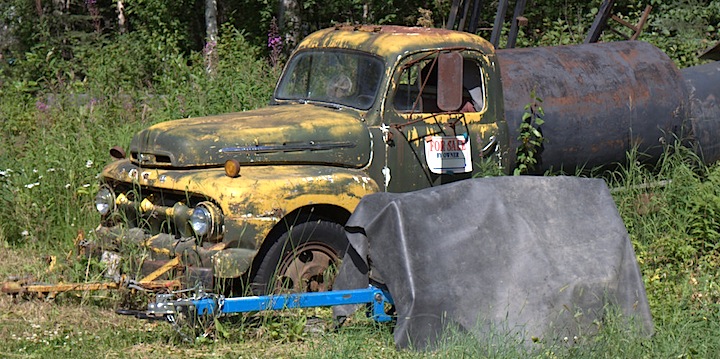
FORD (1951 or 1952) —It appears the "for sale fresh date" has long expired on this 1951 or 1952 Ford F-5 work truck discovered rusting away in Trapper Creek, Alaska. The truck was restyled for 1951 and received only a few minor changes for the 1952 model year. (Photo by Jerry Brown)
FORD (1956) — Its work years long past, this rather bedraggled 1956 Ford F-300 lives in retirement beside a barn in North Carolina. Ford completely redesigned its lineup of trucks in 1953 and added "00" to the end of the existing monikers, thus the F-1 became the F-100, etc. One of the biggest changes was a new "full wrap windshield" extending over to the vertical door post. (Photos by Ralph Gable)
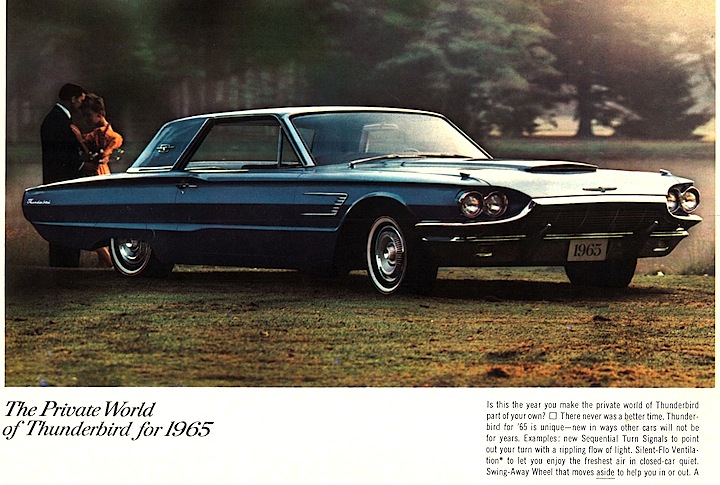
FORD (1965) — This 1965 Ford Thunderbird could stand some tender, loving care, and might still be restorable. The '65 was the second year of the fourth-generation Bird, which ran from 1964 through 1966. It gained a more squared-off appearance from the third generation (1961-63). The standard engine was a 300-horsepower 6.4-liter V-8 mated to a three-speed automatic transmission. Standard front disc brakes were offered for the first time in '65. After record Thunderbird sales in 1964 of 92,000, volume eased off to 75,000 for the 1965 model year. (Photos by Jim Meachen)
FORD (1963) — This 1963 Ford Galaxie was discovered rusting away in some North Carolina weeds among other discarded equipment. The first generation of the Galaxie was produced from 1959 through 1964 with minor mechanical changes each year, but with noticeable styling updates. The '63 was arguably the best looking of the group. 1963 production for all Galaxie styles and engine sizes (V-6 and V-8) totaled 679,652. Horsepower ranged from 85 with the smallest V-6 to 425 with the largest V-8. (Photos by Ralph Gable)
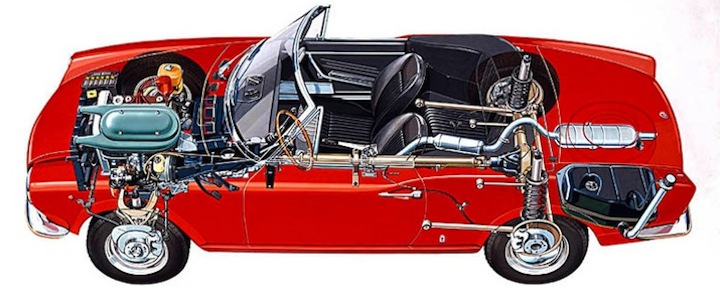
FIAT (EARLY '70S) — This early '70s model Fiat 124 Spider was discovered infested by eastern North Carolina weeds at the back of a lot. Introduced in 1967 as a 2+2 convertible, nearly 200,000 were built through the 1985 model year with about 120,000 sold in the U.S. Four-cylinder horsepower ratings ranged from 90 to 102 through the '70s. Zero to 60 times were around 11.5 seconds, acceptable for roadsters of the era. The Fiat competed with such nameplates as MG and Triumph. Above, a 1970s magazine ad for the Fiat 124 that included a cutout of the car. (Photos by Jim Meachen)
FORD (1986-1991) — Both Ford and General Motors played catch up after Chrysler found instant success with its first minivan introduced in November 1983 as a 1984 model. Ford's answer to the Dodge Caravan and Plymouth Voyager was called the Aerostar and was introduced nearly two yeas later in the summer of 1985 as a 1986 model. The standard engine in early versions was a 2.3-liter 4-cylinder. A 2.8-liter V-6 was optional. In 1988, the 4-cylinder was dropped and the Aerostar became the first minivan with a V-6 as standard equipment. This first-generation minivan (1986-1991) was found behind a garage in eastern North Carolina apparently done with the chores of driving life. (Photos by Jim Meachen)
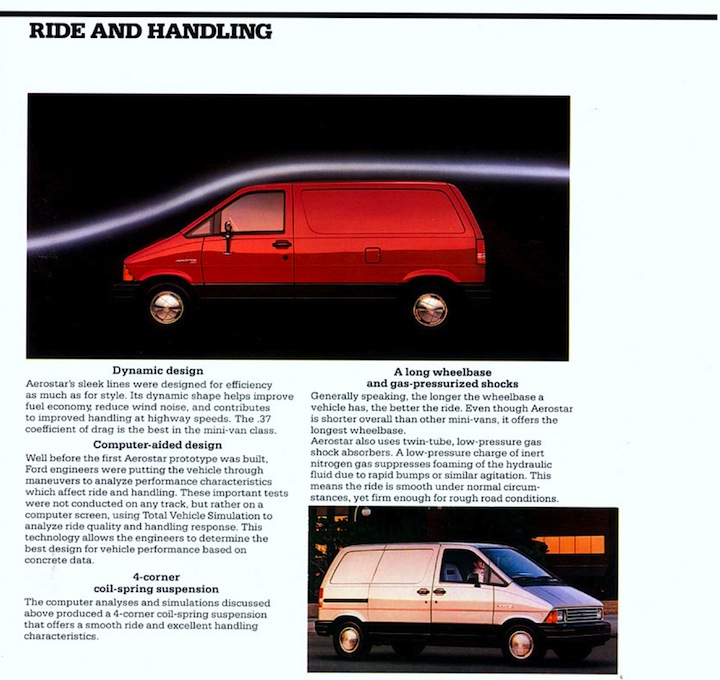
FORD (1967) — A Mustang has turned into vegetation in an eastern North Carolina field. (Photos by Jim Meachen)
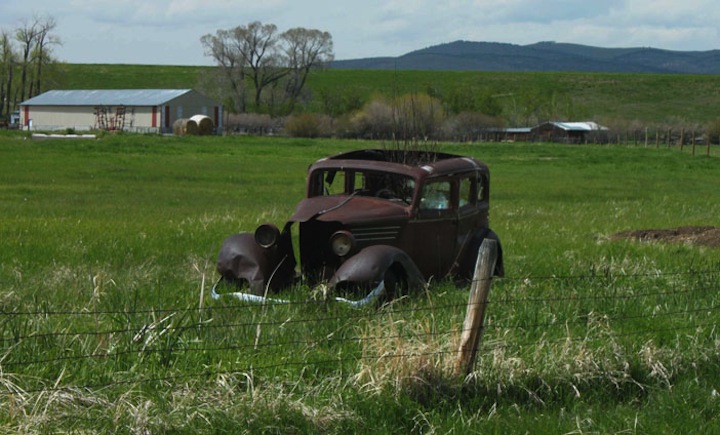
FORD (1936) — What looks like a 1936 Ford complete with a tree or shrub growing out of its roof was found retired in a pasture near West Yellowstone, Montana. (Photo by Jerry Brown)
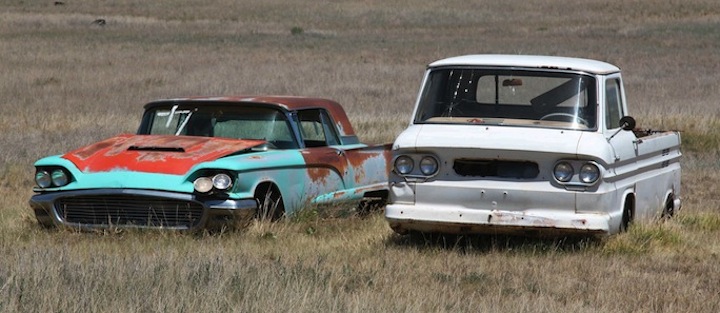
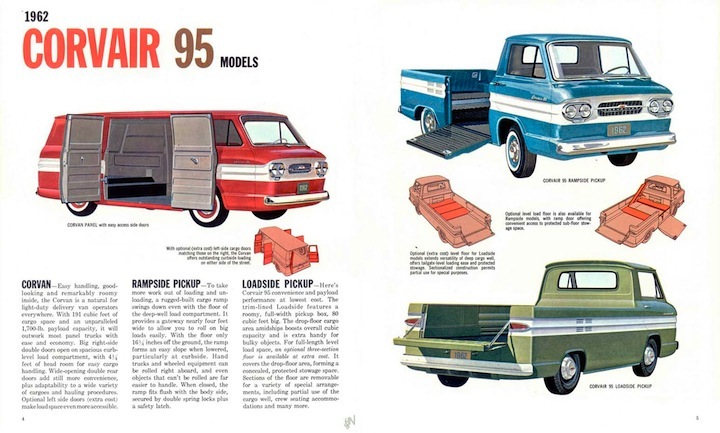
FORD — A 1958 or '59 Ford Thunderbird resides next to a 1960-1962 Chevrolet Covair Rampside. Above, the 1962 Corvair Rampside is depicited in this ad for the Corvair van and pickup. (Photo by Jerry Brown)
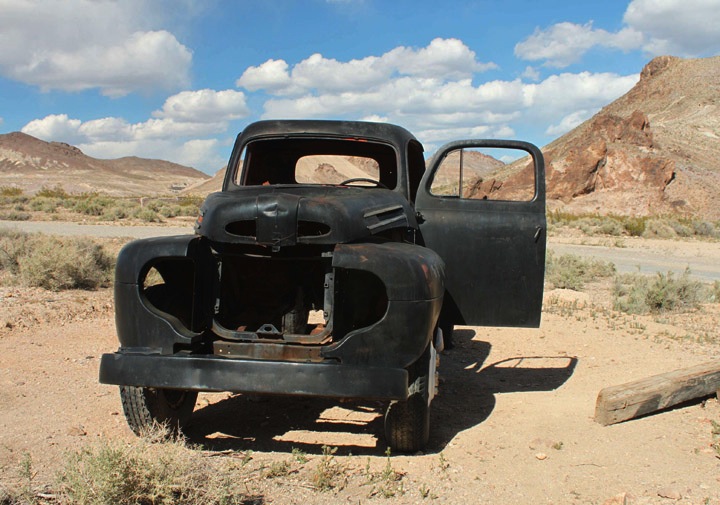
FORD (Late '40s) — The remains of a Ford pickup — could be a 1948, 1949 or 1950 — in Rhyolyte, Nev. (Photo by Jerry Brown)
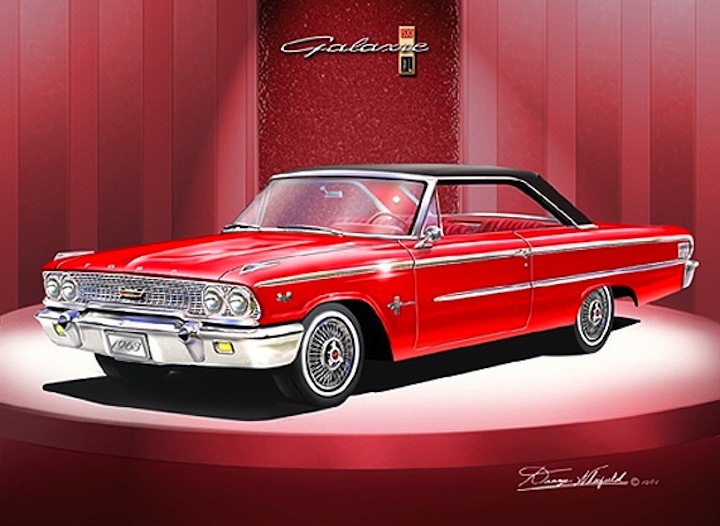
FORD (1963) — A Ford Galaxie suffers the indignity of being crowned by tires and wheels. Below a magazine advertisement depicts how the top-end 1963 Ford looked when new. (Top photo by Jim Meachen)
FORD (1951) This Ford rests peacefully as it sinks into the eastern North Carolina dirt. (Photo by Jim Meachen)
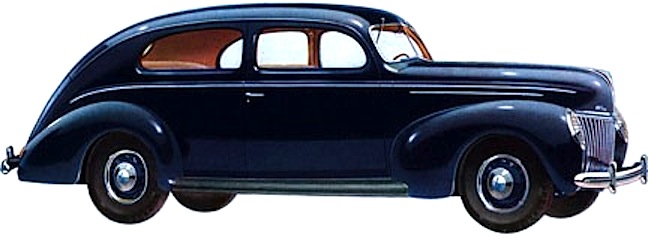
FORD (1939) — A Ford Tudor Sedan decays in its final resting place in eastern North Carolina. Above, what the popular model looked like as depicted in a 1939 Ford magazine advertisement. (Photos by Jim Meachen)
FORD (1980) — This Ford F-350 tow truck rests in eastern North Carolina weeds, its days of duty apparently at an end. 1980 marked the beginning of the seventh generation Ford truck, the first ground-up remake of the popular F-Series since 1965. (Photos by Jim Meachen)
FORD (1947 or 1948) This 1947 or '48 Ford is rusting into oblivion in a western Virginia yard. It is one of nearly 860,000 Fords that were sold during the two model years. The 1948s were virtually identical to the 1947s, though the early 1947s were really 1946s, while the freshened "1947-1/2" models went on to become 1948s. (Photos by Ralph Gable)
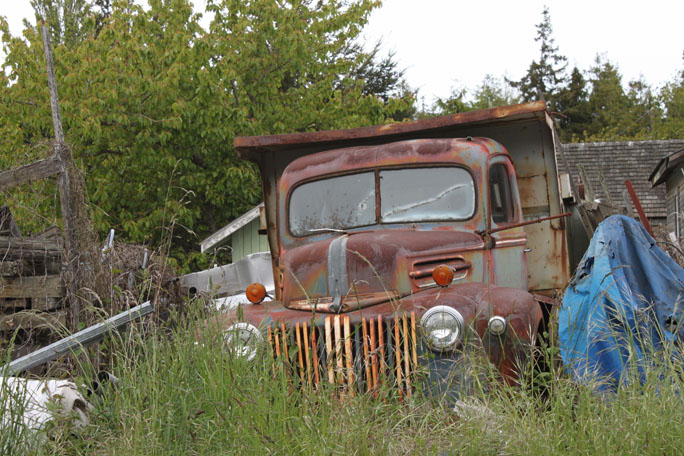
FORD (1947) — This Ford dump truck was found near Port Townsend, Wash. (Photo by Jerry Brown)
FORD — A 1952 or 1953 Ford hulk is burdened with a door, probably its own? (Photo by Jim Meachen)
FORD — This 1964 or 1965 Ford truck, spotted in Lenoir County, N.C., has probably seen its last duty as a hauler. (Photo by Jim Meachen)
FORD (1937) — A 1937 Ford has been striped to a skeleton. It might have been in the early stages of restoration before it was left to decay in a field. Ford did some redesign work on the 1937 Ford, creating a V-shaped grille and incorporating the headlights into the fenders. The new headlight treatment was found on the Standard and DeLuxe trim versions. Slantback sedans gained a rear trunk door. For 1937 an entry-level 2.2-liter V-8 was added. The popular 3.6-liter flathead V-8 was still the best seller. (Photos by Jim Meachen)
FORD (1965) — Weeds will soon overtake this Ford pickup. (Photo by Jim Meachen)
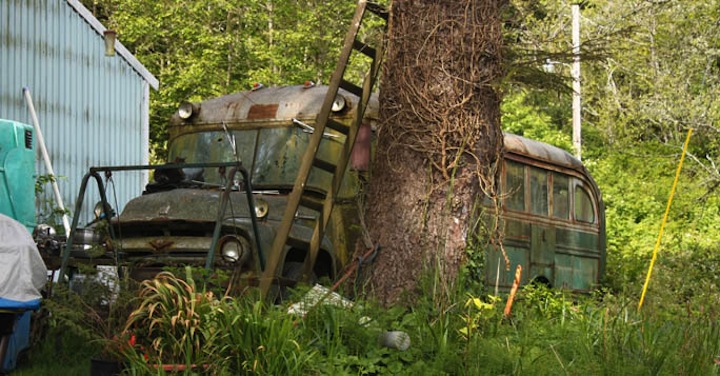
FORD (1956) — The hood of a used-up 1956 Ford school bus has become the resting place for a cat in northern California. (Photo by Jerry Brown)
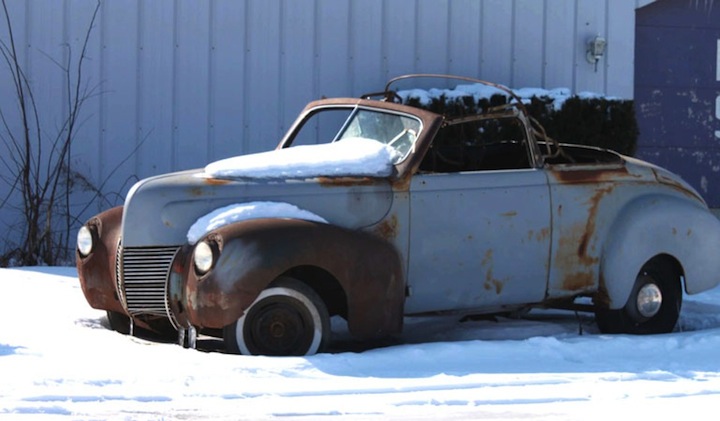
FORD (circa 1939) — This Ford or Mercury (difficult to distinguish), minus a roof, was found in the Wisconsin snow (Photo by Jerry Brown)
FORD (circa 1990) — O.J. Simpson wouldn't get far in this abandoned white Ford Bronco. (Photo by Ralph Gable)
FORD (1961) — A stripped-out 1961 Ford Galaxie rests in the grass in Virginia. Ford began selling performance in 1961 with a 6.4-liter V-8 available with either a four-barrel carburetor or with three two-barrel carburetors making 401 horsepower. Can't tell what once was under the hood of this coupe. (Photo by Ralph Gable)
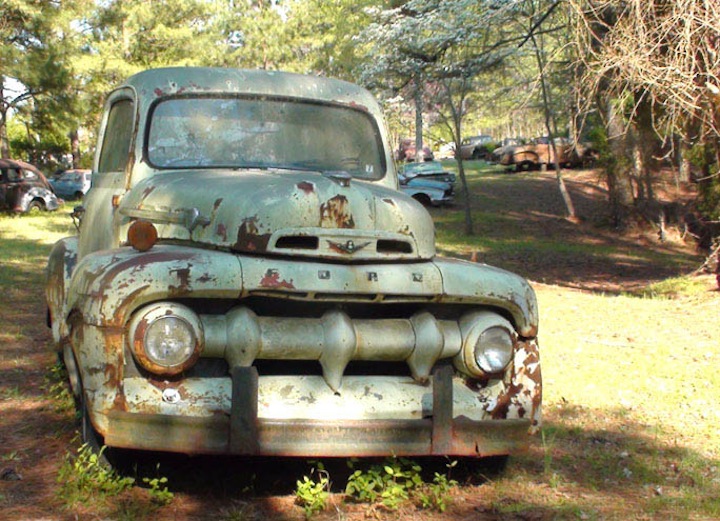
FORD (1952) — There may be some restorable hope left for this Ford pickup found in eastern N.C. (Photo by Jim Meachen)
FORD (1966) — An abandoned Ford has been found in an abandoned barn in eastern North Carolina. (Photo by Jim Meachen)
FORD (mid 90s) — This L Series mid-1990s Ford truck found in eastern North Carolina appears to have made its final delivery. L Series trucks came with either a gas engine or a diesel engine in three configurations L-600/6000, L-700/7000 and L-800/8000. (Photos by Jim Meachen)
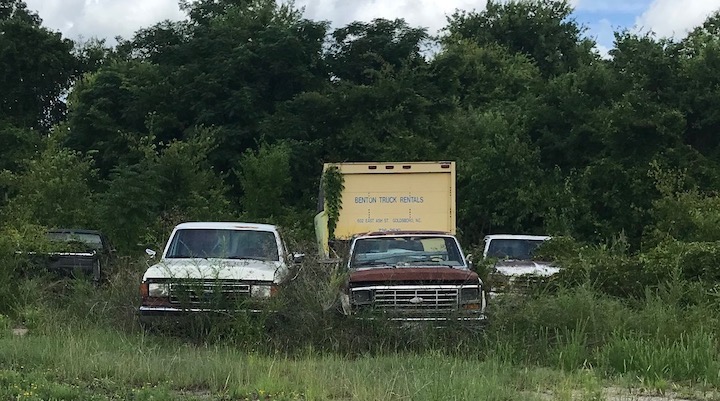
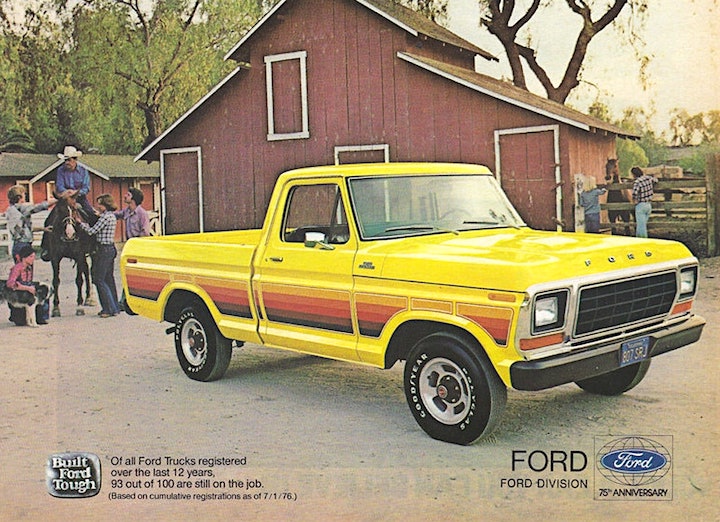
FORD (circa 1980-1985) — These seventh-generation (1980-1986) Ford trucks have ben retired to a storage area, their useful life over. The 7th generation was the final version of the F-Series to offer a three-speed, column-shifted manual transmission; it is also the second-to-last vehicle sold in the United States with this configuration. (Photo by Jim Meachen)
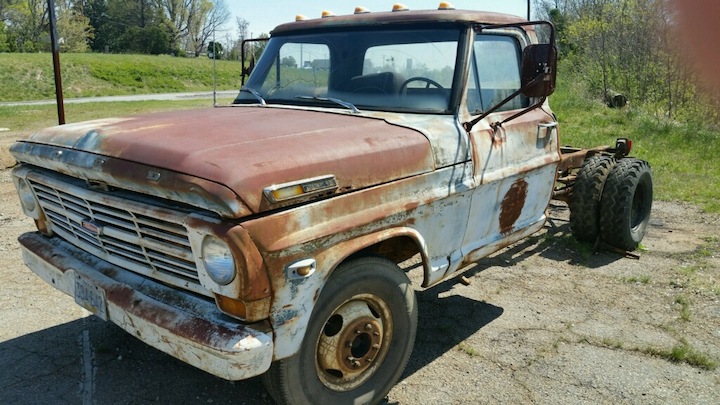
FORD (1969) — This 1969 Ford might still have some life left as a work truck. When this picture was snapped, it was in at least temporary retirement on the side of a road in North Carolina. (Photo by Ralph Gable)
